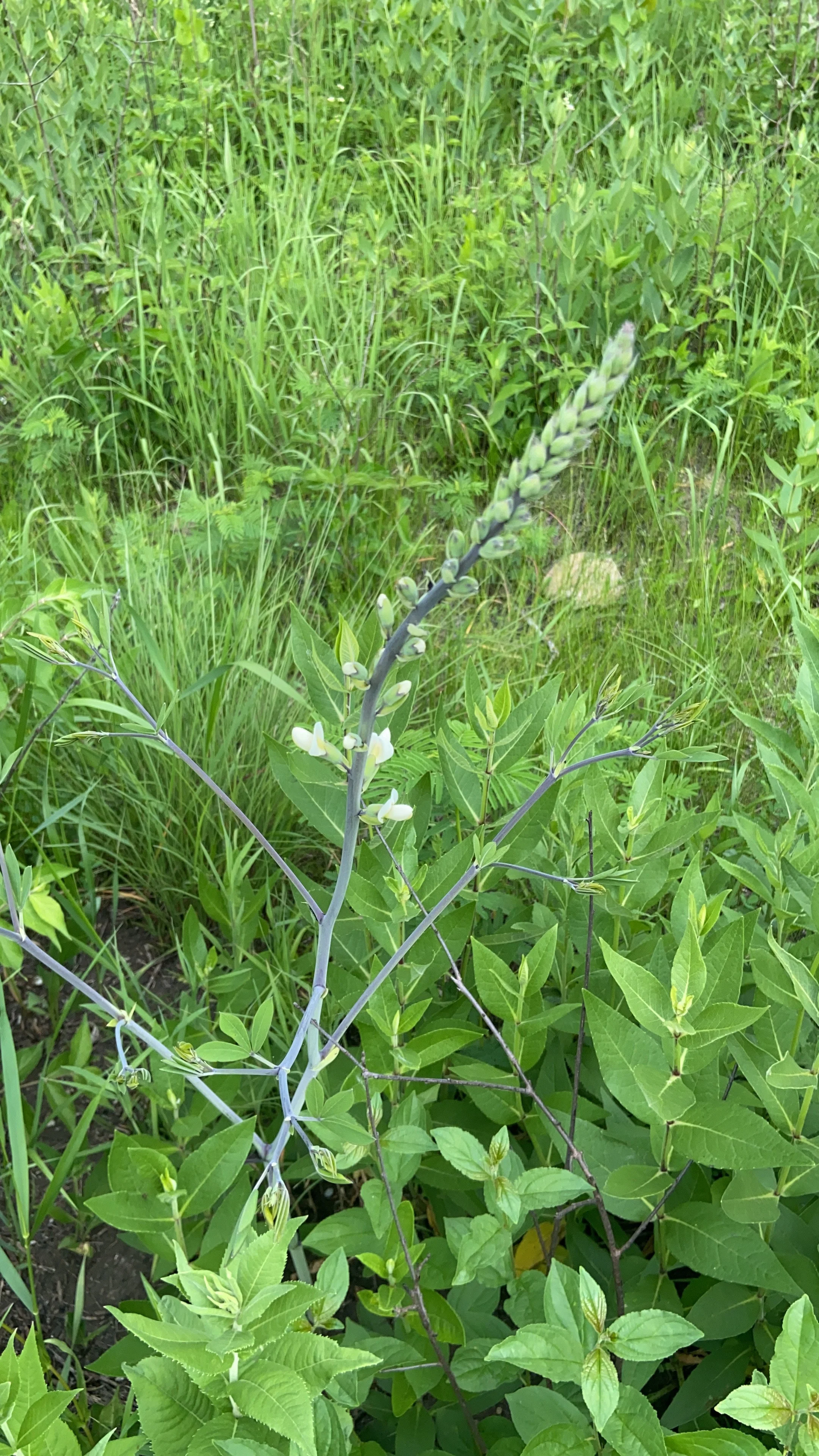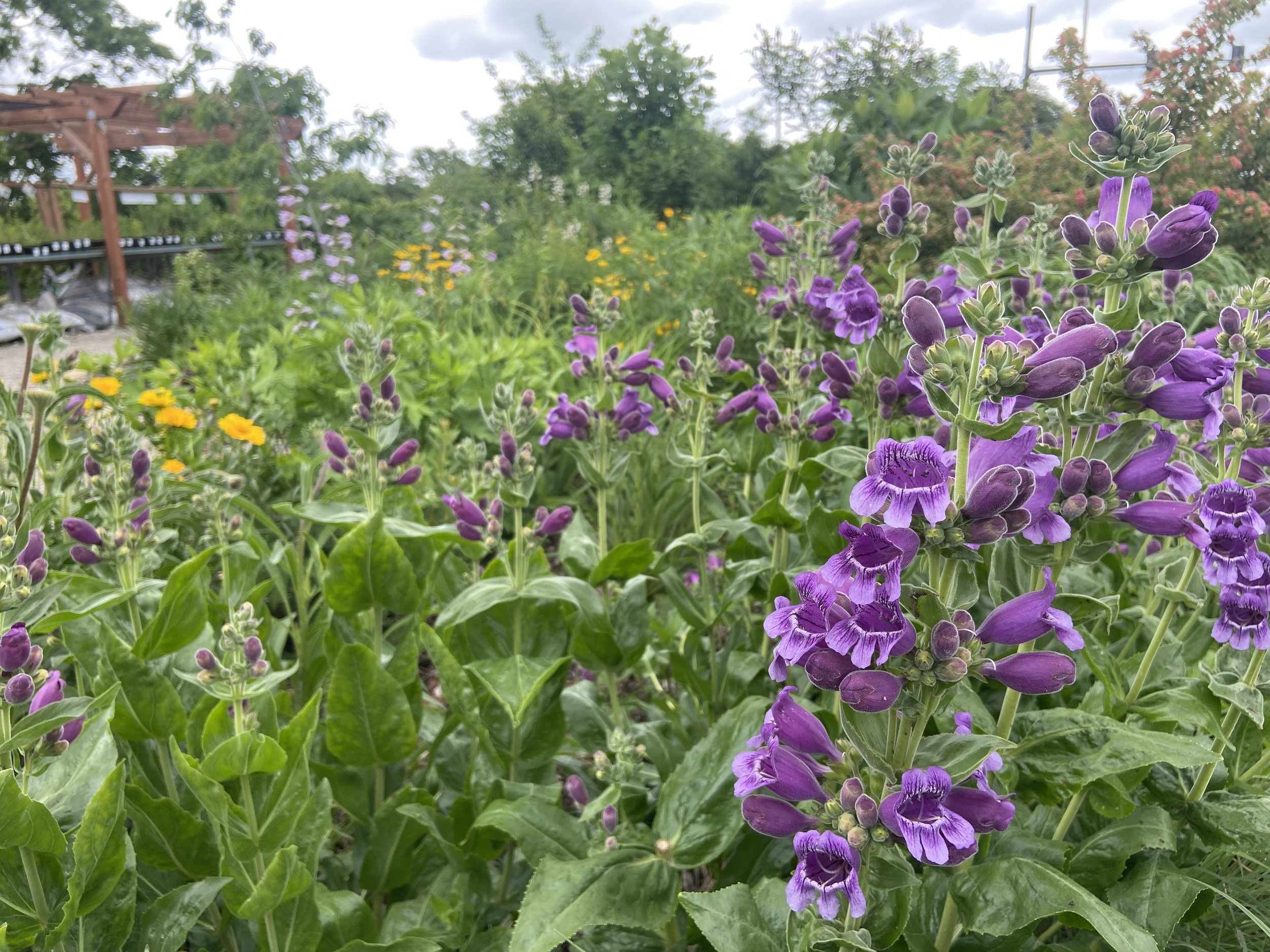
Forbs
Learn about our Native Forbs and vines
-

Achillea millefolium / Yarrow
Type: Perennial
Habitat: Disturbed prairies
Light: Full sun to part sun
Soil: Dry to medium moisture
Growth: 2’ - 3’ tall
Bloom: White from May- June
Spread: spreads by rhizome and by seed. Can spread prolifically to form large colonies
Maintenance: low maintenance in large areas. Quarterly maintenance to keep from spreading in small landscapes.
Benefits: Pollinators, butterflies, bees, erosion control, teaInfo: Beautiful spring bloomer that is commonly planted in herb gardens. Can be used in mass plantings for large areas. Can sometimes flop over in extreme humidity, so sometimes nice to plant next to grasses or sedges to keep it more upright.
Native Range: most counties in KS, MO, IA and NE
-

Agastache nepetoides/ Yellow giant hysspo
Type: Perennial
Habitat: Low, moist edge of the woods and meadows
Light: Part shade to part sun
Soil: Medium moisture
Growth: 4’-6’ tall
Bloom: Yellow from July-Oct
Spreads: prolifically by seed and slowly by rhizome
Maintenance: remove plants that have seeded in unwanted areas. Plant can be staked to prevent falling over
Benefits: bumblebees, flies, predatory insectsInfo: Prolific spreader by seed with tall flowers. Very valuable to a large variety of pollinators including bees, butterflies, Syrphid flies, and many species of predatory insects. Does not do well in dry sunny areas. This plants primary use in ornamental gardens is for its foliage as only several of its flowers are ever in bloom at the one time.
Native range: Eastern KS, most counties in MO, Southeast NE, a few Southern and Western counties in IA
-
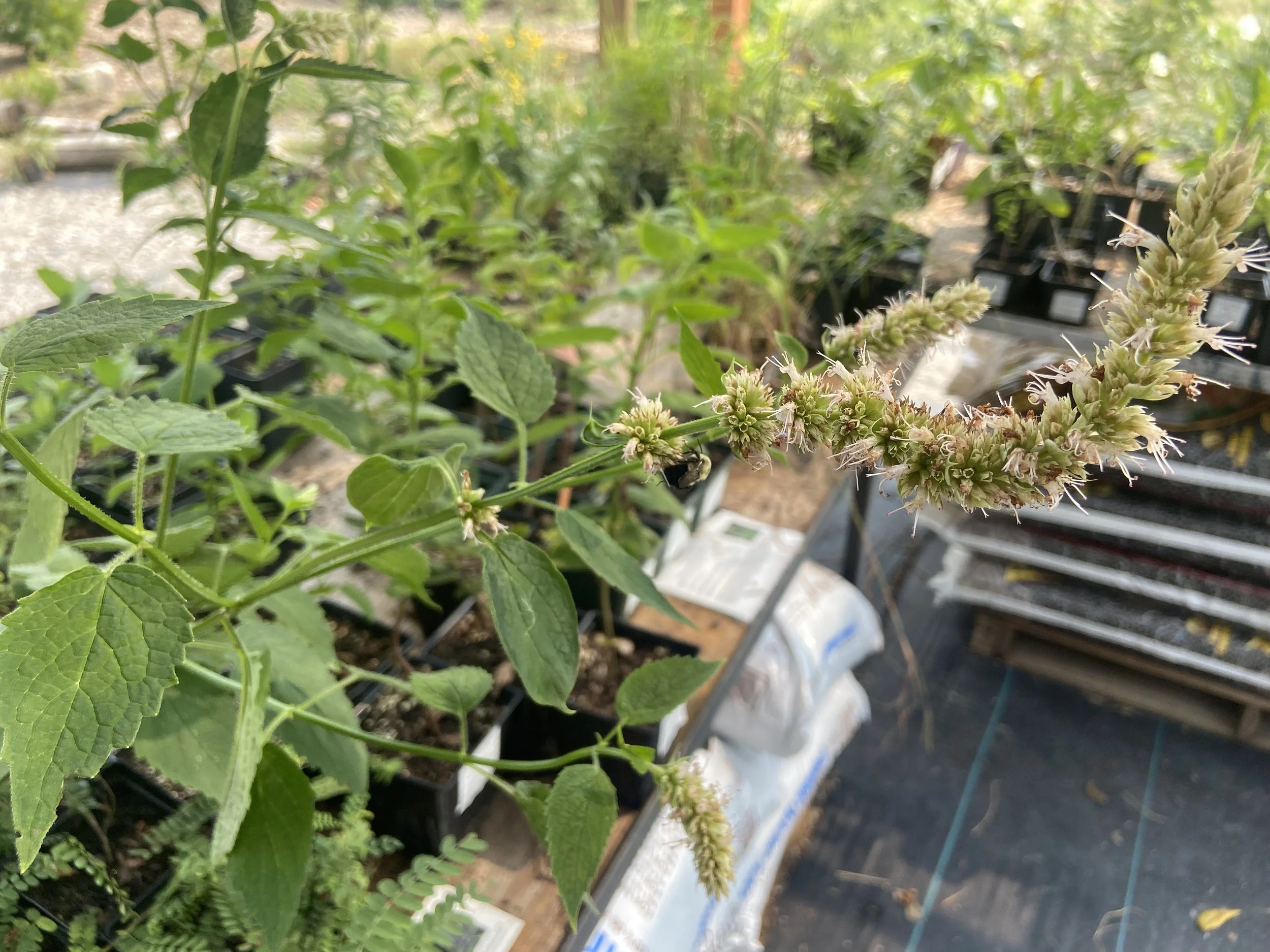
Agastache scrophulariifolia / Purple Giant Hyssop
Type: Perennial
Habitat: Rare in Missouri. Wet edge of the woods or meadows
Light: Full/Partial
Soil: moist rich soils
Growth: 6’ tall columnar
Bloom: White to pale purple from July-Oct
Spread: Prolifically by seed and by rhizome slowly
Maintenance: remove plants that have seeded in unwanted areas. Can be staked if falling over
Benefits: Bumblebees, predatory insectsInfo: large plant best suited for larger landscapes. It blooms actually appear to be almost white from a distance but up close are a very pale purple. It is a host plant to the endangered Rusty Patched Bumble Bee. Purple Giant Hyssop has a very long bloom time while also being a nectar rich plant these two things in combination make this plant very popular with butterflies. In some Eastern states it is considered a endangered species.
Native range: Only Leavenworth County in KS, limited counties in NW Missouri, SE Nebraska and SW Iowa
-
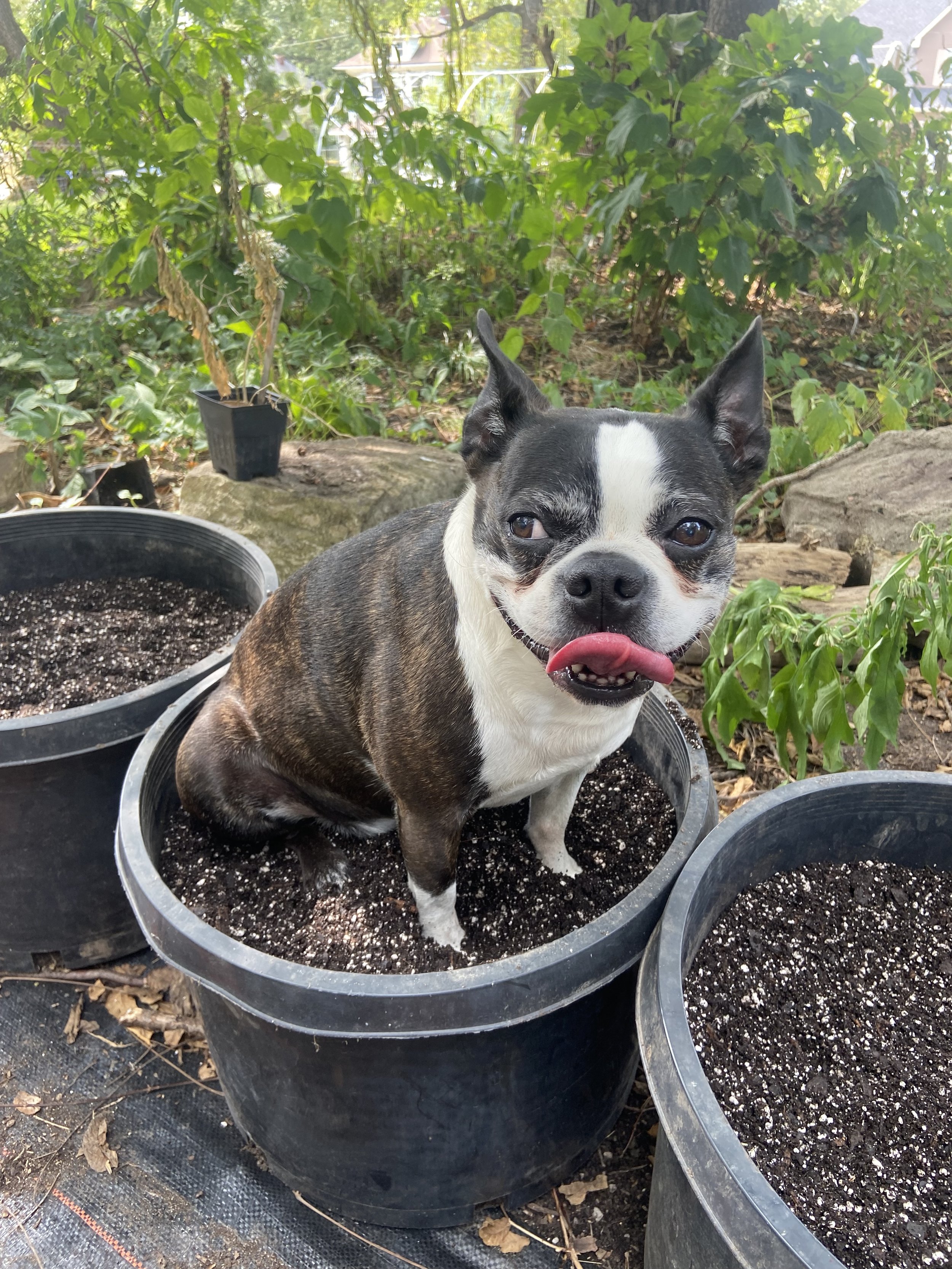
Allium canadense / Wild garlic
Type: Perennial bulb
Habitat: Prairies and savannas
Light: Full sun
Soil: Dry to medium
Growth: 1’ tall
Bloom: White/Pink April-June
Spread: bulb offsets and by seed less successfully
Maintenance: remove plants that have seeded in unwanted areas
Benefits: flies, small beesInfo: This small native plant is not only beautiful, but deer resistant. It spreads by bulbs and seeds. like most other wild garlics it has slender foliage that blinds in amongst grasses and sedges, but when stems are trampled or disturbed you can smell the onion like aroma. It is easy to distinguished from other wild garlics by its showy display of white/pink flowers in the spring.
Native range:
-
Allium cernuum / Nodding onion
Type: Perennial bulb
Native Habitat: Open woods, glades, slopes
Sun: Full to Part sun
Soil: Medium moisture
Height: 1.5’ tall
Bloom: Purple from July-August
Spreads: by seed
Maintenance: deadhead flowers before seeds mature to prevent spread. Bulbets can be divided in fall for more plants.
Benefits: Pollinators, edible, hummingbirds, drought tolerant
Insect interactions:Info: These showy native onions have large flowering bulbs that are deer resistant and a great plant for pollinators. Spread can easily controlled by deadheading flowers before seeds mature. The leaves and bulbs of this plant can be used in cooking or eaten raw. Bulblets can be divided and planted in fall. This plant can be a great addition to rock gardens, cottage gardens, and as a boarder planting for garden beds. This plant is attractive to butterflies and hummingbird.
-

Allium stellatum / Prairie onion
Type: Perennial bulb
Habitat: glades, open woodlands, prairies and slopes
Light: Full Sun to Part Shade
Soil: Medium to Dry
Growth: 1-1.5’high .5-1’ wide
Bloom: reddish pink blooms in July-September
Spread: seed and bulbet
Maintenance: bulbets can be divided in the fall. Plant can be left to reseed so new onions can form a green mulch layer in the garden. If spread is unwanted, deadhead flowers before they go to seed.
Benefits: Bees, flies, beetles, hummingbirds, edible, drought resistant, deer resistant,Info: This edible native perennial can be found in rocky soil in the Ozark region. Commonly eaten by the Native Americans and early pioneers, it was used in soups or just eaten raw. This showy plant is very drought and deer tolerant and makes a great addition to any native or cottage garden. Also pared well with showy wild garlic in order to get similar blooms from April-September.
Native range: Ozarks and central Kansas
-

Amsonia illustris / Ozark bluestar
Light: Full sun to Part shade
Soil: Medium to dry
Growth: 3’ tall , 1.5 Wide
Bloom: Blue from April-MayThis southern Missouri native is commonly found growing along streams in sandy rocky soil. When grown in the shade may require staking to prevent plants from flopping over. When grown in full sun make nice round clumps that can be easily pruned to shape once blooms are finished if desired. The Shiny leaves that turn a beautiful yellow in the Fall. Ozark Bluestar is a great addition to any native garden.
-
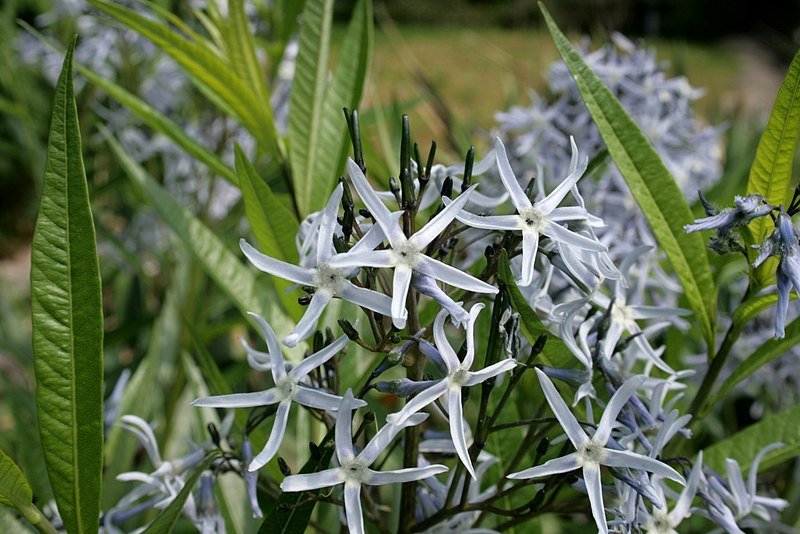
Amsonia tabernaemontana / Eastern bluestar
Type: Perennial
Native Habitat: wet areas in woodlands and prairies
Light: Part Shade
Soil: Wet to average
Growth: 1-3’ tall multi-stemmed clump
Bloom: Blue/purple blooms in March-May
Spreads: by seed
Benefits: drought tolerant, good fall color, cut flowers,Info: This ornamental native perennial grows throughout the midwest and can be found in woods or on the plains. It grows best in wet, sandy soils. This species has wonderful golden fall color that adds interest throughout the season.
Design suggestions: This plant grows and blooms better in the sun, but can tolerate part shade. Excellent for mass plantings as borders, or in forma gardens. Also a great addition to naturalized gardens or rain gardens
-
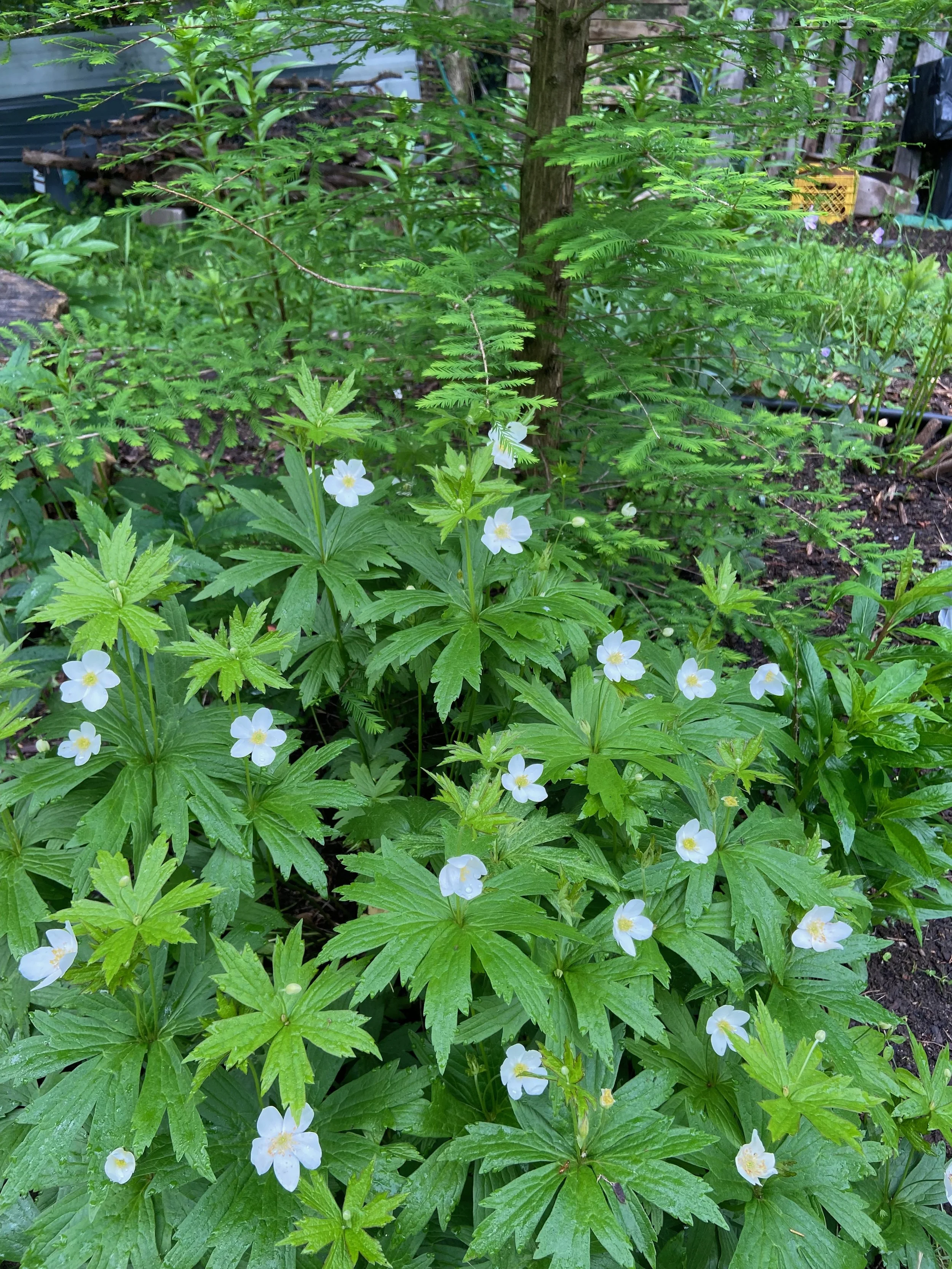
Anemone canadensis / Canada anemone
Type: Perennial
Native habitat: damp edge of the woods
Light: Full Sun to Part Shade
Soil: Medium to wet well drained soil
Growth: 1’-2’ tall 2’-2.5’ wide
Bloom: White from April-JuneInfo: This native perennial grows best in wet to medium well drained soils. Commonly found in Missouri along the Missouri and Mississippi Rivers, it spreads through rhizomes to create a nice ground cover making it a good native alternative to Vinca or Ivy.
-
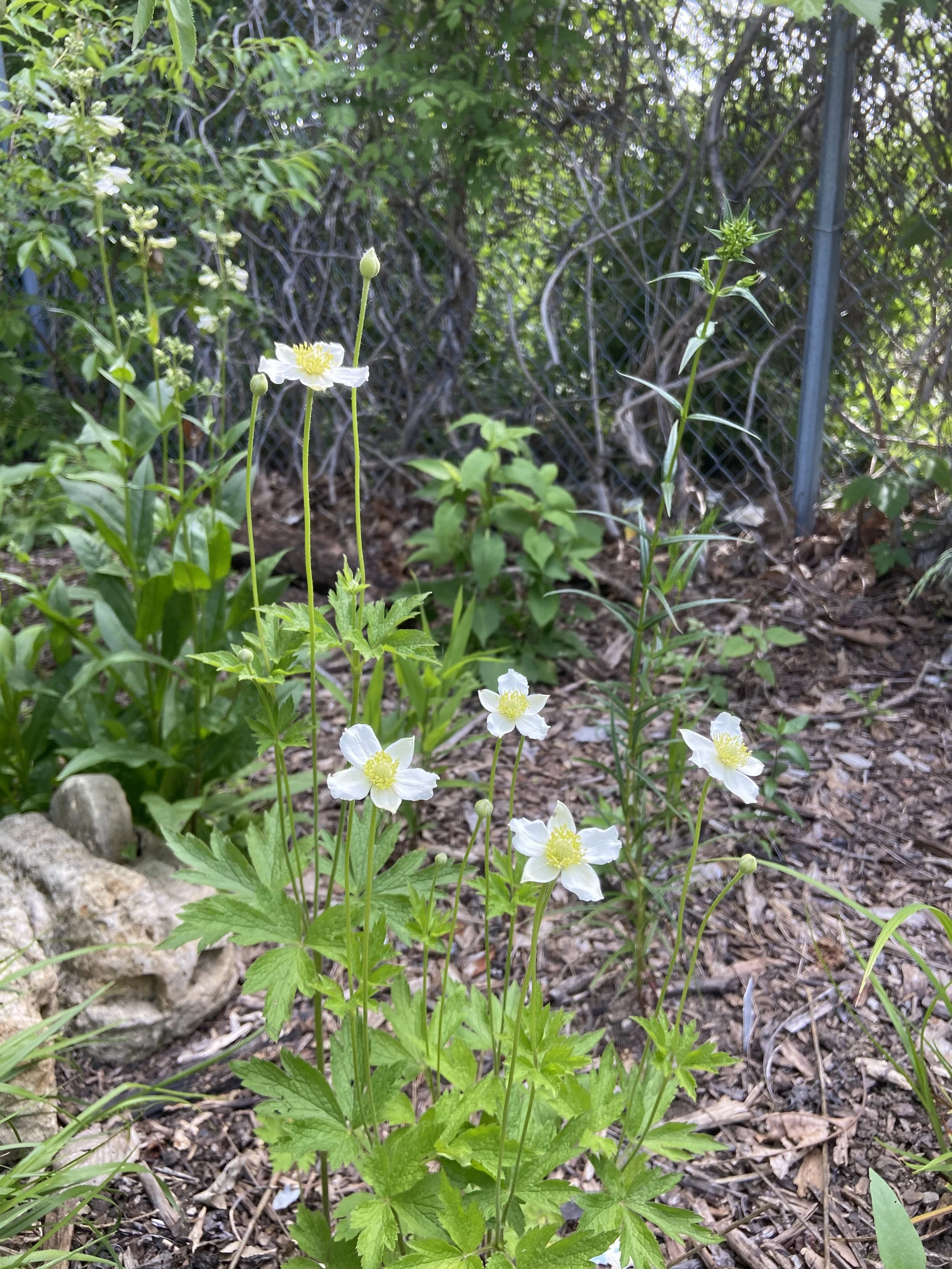
Anemone virginiana/ Tall Thimbleweed
Type: Perennial
Native habitat: open woods
Light: Full shade to part shade
Soil: Medium to wet
Growth: 1’ - 2’ tall 1’ wide
Bloom: White from June-August
Spreads: by seedInfo: Anemone virginiana, or tall thimbleweed, is a perennial wildflower known for its slender stems and white flowers. Thriving in moist woodlands and meadows, it blooms in late spring to early summer. This plant supports pollinators and adds elegance to natural landscapes with its airy blooms and feathery seed heads.
Host plant to mining bees, small carpenter bees, sweat bees, green sweat bees and yellow faced bees (Holm, Heather. Pollinators of Native Plants: Attract, Observe and Identify Pollinators and Beneficial Insects with Native Plants. Pollinator Press, LLC, 2014.)
-

Antennaria neglecta / Prairie Pussytoes
Type: Perennial
Native Habitat: grasslands, woodlands and prairies
Light: Full sun to part shade
Soil: medium to dry soil moisture
Growth: 4” tall , 1’ wide
Bloom: White from April-June
Spread: seed and rhizome
Benefits: butterflies, bees, ground coverInfo: This Missouri Native can be found in grasslands, woodlands, and dry prairies. it grows best in rocky or sandy well drained soil. It is a low growing ground cover that spreads well and is great for small or large landscapes. A host plant for American painted lady butterfly caterpillars. great addition to rock gardens, open woodland gardens, boarder plantings, and also does well on slopes.
-

Antennaria parlinii / Pussytoes
Type: perennial
Native Habitat: open woodlands, prairies
Light: Full sun to part shade
Soil: Dry sandy or rocky
Growth: 1’ tall bloom foliage that hugs the ground
Bloom: White in May
Spreads: seed and rhizome
Benefits: pollinators, ground cover, erosion control, deer resistantInfo: Antennaria parlinii, or Parlin's Pussytoes, is a perennial plant native to North America. Thriving in well-drained soils and partial sun, it's found in woodlands and meadows. Its fuzzy flowers attract pollinators, and its roots contribute to erosion control. A host plant for painted lady butterfly caterpillars.
-

Aquilegia canadensis / Columbine
Type: Perennial
Native Habitat: dry woodlands, rock outcroppings, meadows
Light: Full sun to part shade
Soil: medium moisture
Growth: 2’-3’ tall 1’-2’ wide
Bloom: red/yellow April-May
Spreads: seedInfo: This native, perennial can be found in woods through out the state. Its early spring flowers are great for attracting humming birds. Under proper conditions, can be a prolific reseeder and form large colonies. Great for large areas that need to be filled in or creating spring interest in the garden. Dead-heading and watering will encourage additional blooms and keep to foliage looking attractive longer in the season. This is a must have in any woodland or shade garden and can be a great addition to already naturalized areas.
-

Aralia racemosa / Spikenard
Type: Perennial
Native Habitat: Woodlands
Light: Part shade to shade
Soil: Wet to medium wet
Growth: 4’ tall and wide
Bloom: Green from July-AugustInfo: This Missouri Native can be found in woodlands growing in moist fertile soils along slopes and cliffs. It has a shrub like growth habit and over time can form thickets by spreading rhizomes. Its attractive berries are a delight for birds. This plant is a member of the ginseng family and its roots can be used for flavoring teas and to make root beer. The roots have also been used medicinal in the past. Spikenard is a great addition to any part sun to shade woodland gardens or native plantings.
-

Arisaema dracontium/ Green dragon
Light: part shade to full shade
Soil: medium to wet soil
Growth: 3’ tall
Bloom: green from May-JuneInfo: Great for rain gardens. Nice, unique plan to add to shade gardens
-
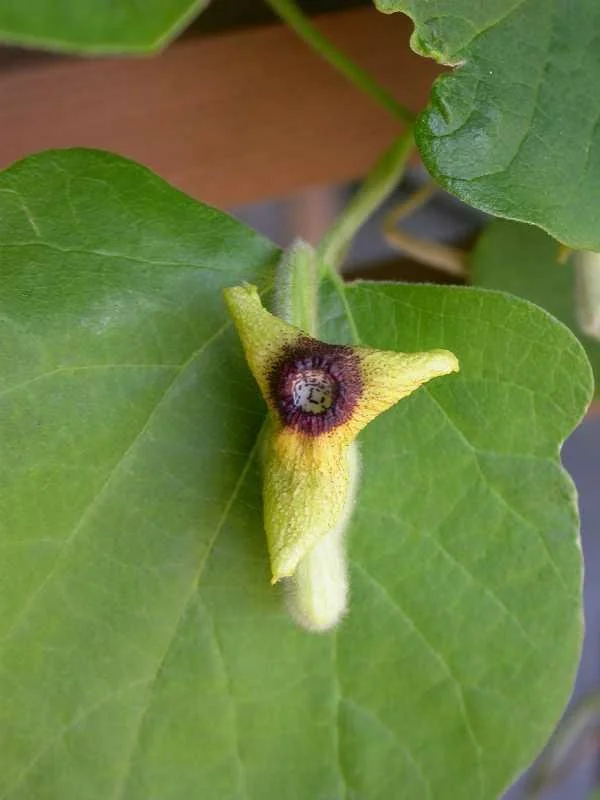
Aristolochia tomentosa / Dutchman's Pipe Vine
Light: Full Sun to Part Shade
Soil: Medium
Growth: 20-30’ tall 5-10’ wide vine
Bloom": pipe shaped greenish yellow in May-JuneInfo: This native vine is the host plant for the larva of the pipe vine swallowtail butterfly. This vine is seen in the wild growing up trees in moist woods often along creeks or streams. The attractive blooms resemble small popes. This is a great vine option from growing on arbors, trellises, and on fences
Photo credit: Mo botanical gardens
-
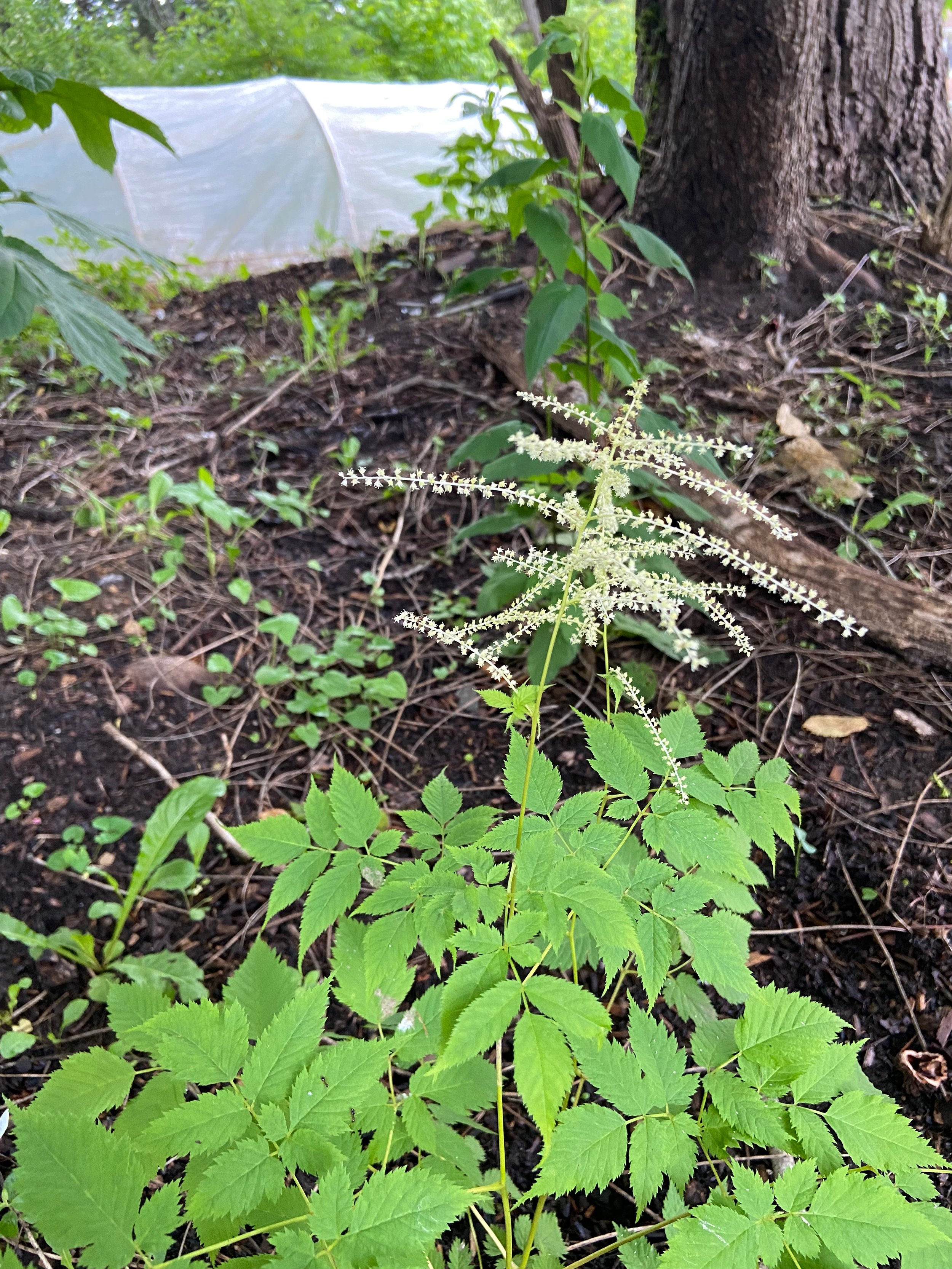
Arnucus dioicus / White goat's Beard
Type: Perennial
Native Habitat: Moist woodlands
Light: Part Sun
Soil: Medium to Wet
Growth: 2-4’ wide , 4-6’ tall
Bloom: WhiteInfo: This Native perennial is found in moist woodlands and grows best in wet conditions especially if planted full sun. This species is dioecious meaning there are both male and female plants. Male plants have a more attractive bloom, but female plants have attractive seed pods. In landscapes this plants looks stunning in large masses. It is the larval host for the Dusky Azure
-

Artemisia ludoviciana / Prairie Sage
Type: Perennial
Native Habitat: Glades, rocky prairies, bluffs
Light: Full Sun
Soil Moisture: Dry to Medium well drained
Growth: 2’-3’ tall
Bloom: Yellow from August-September
Spreads: prolific spreader by rhizome and seed in dry, well drained areasInfo: This native perennial is very drought tolerant and can form large colonies that are perfect for filling in large areas. It can eve handle being mowed once established. Does not do well in wet or poorly drained areas. In small areas, Its silver foliage is very aromatic and also medicinal. Its leaves can be used as a tea for stomach issues, a stronger tea can be brewed to use as wash for deodorant for underarms and feet.
-
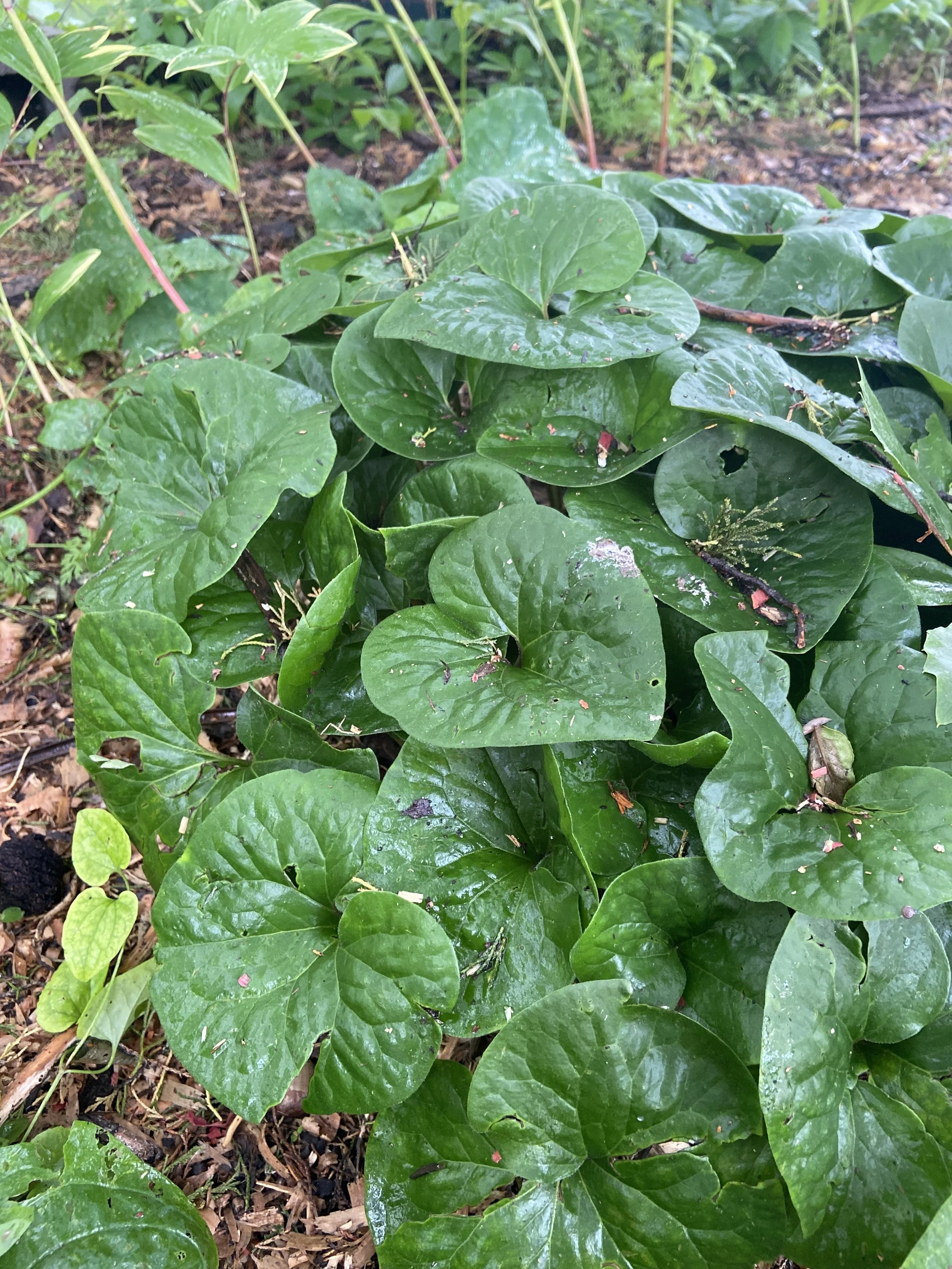
Asarum canadense / Wild Ginger
Type: Perennial
Native Habitat: woodlands
Light: Part Shade to Full Sun
Soil: Medium to Wet
Growth: 1’ tall
Bloom: Purple/brownish blooms in April-May
Spread: rhizome and slowly by seed.Info: This native plant can be found in the woods throughout the state. It is a low ground cover with leaves that can be up to 6’ wide. Spreading by rhizomes, they can form a lovely carpet of green ground cover. The slender roots can be used as ginger substitute. Great for edging or ground cover in garden beds.
-
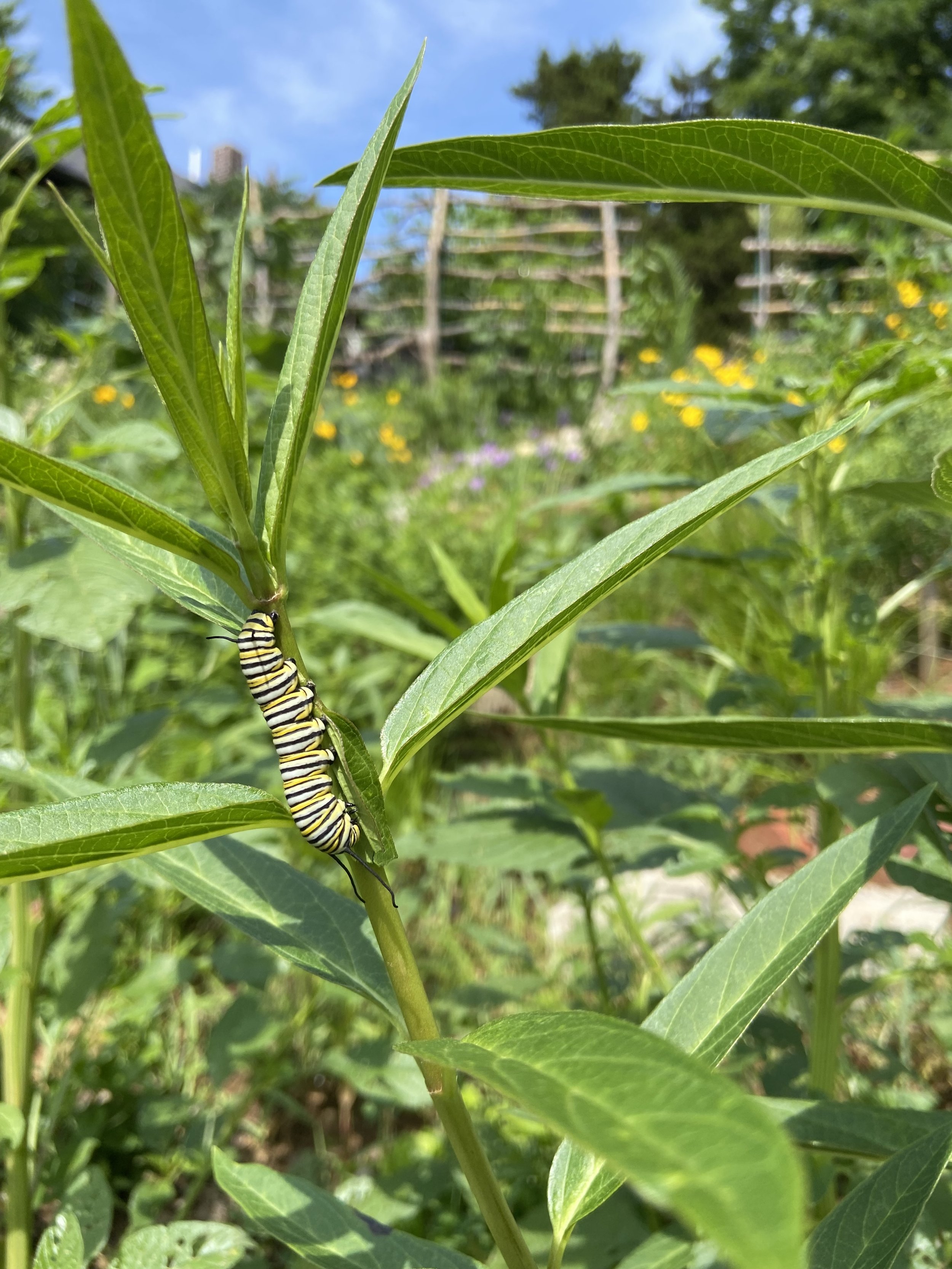
Asclepias incarnata / Swamp milkweed
Type: Perennial
Native Habitat: Swamps, wet meadows, river edges
Light: Full Sun
Soil: medium to wet
Growth: 4’-5’ tall and 2’-3’ wide
Bloom: Pink from July-August
Spreads: by seedInfo: This native Milkweed also known as Swamp milkweed is great for monarchs and other butterflies. In the wild you can see this plant growing in swamps, near rivers, around ponds, and other wet meadows or fields. It has a clump forming growth habit. Rose milk weed is a great addition to any butterfly garden or wet area.
-
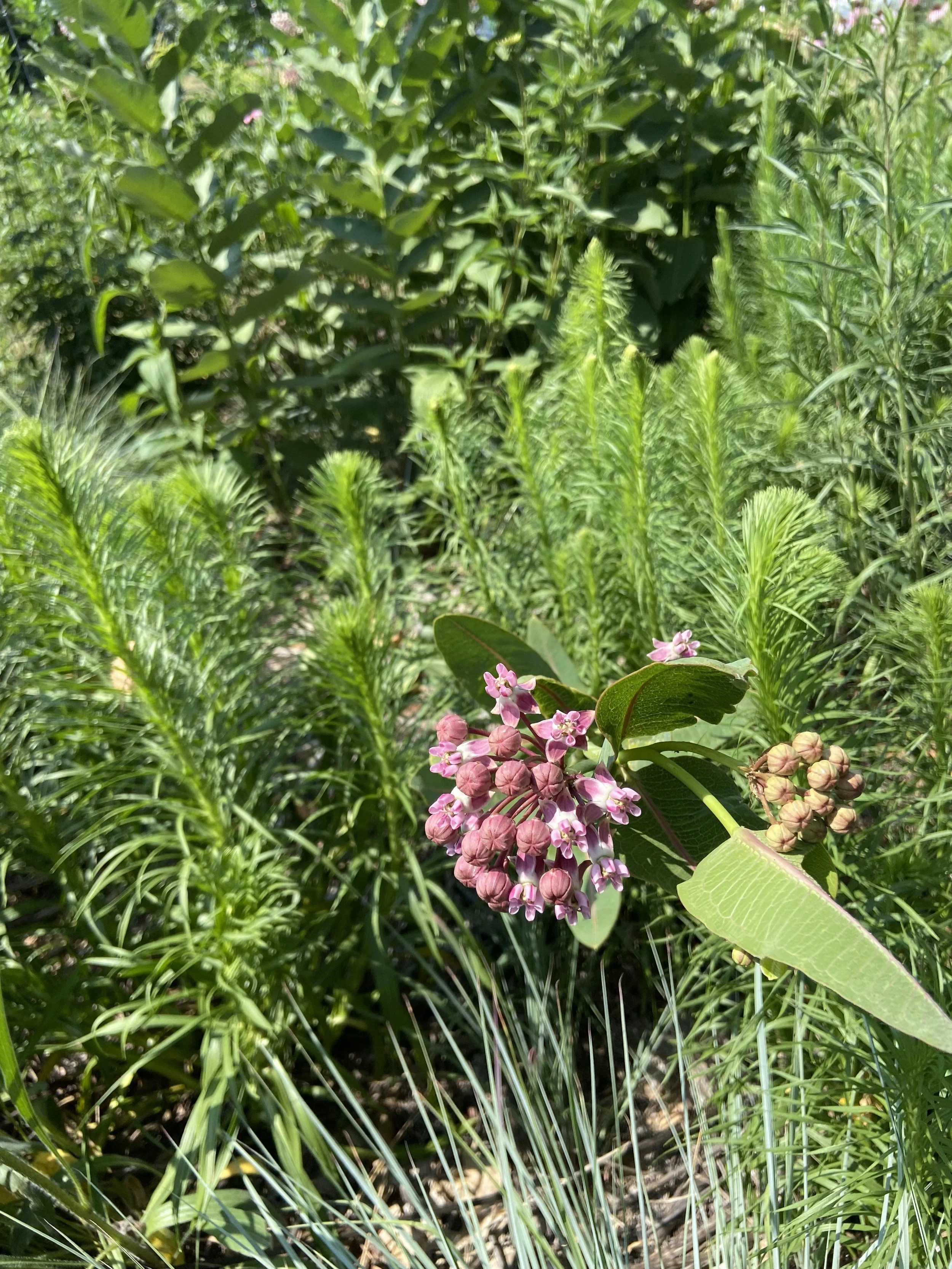
Asclepias sullivantii /Prairie milkweed
Sun: Full Sun
Soil: medium to medium wet
Growth: 2’-3’ tall and 1’-1.5’ spread
Bloom: Pink bloom June-JulyInfo: This Native milkweed also know as smooth milkweed has a similar look as common milkweed except its stems and seed pod are smooth. In the wild you can find this plant growing in wet prairies and along rivers. Like other members of the milkweed family this plant plays a significant role as a food source for monarch caterpillars its blooms are also a important nectar source for adult butterflies.
-
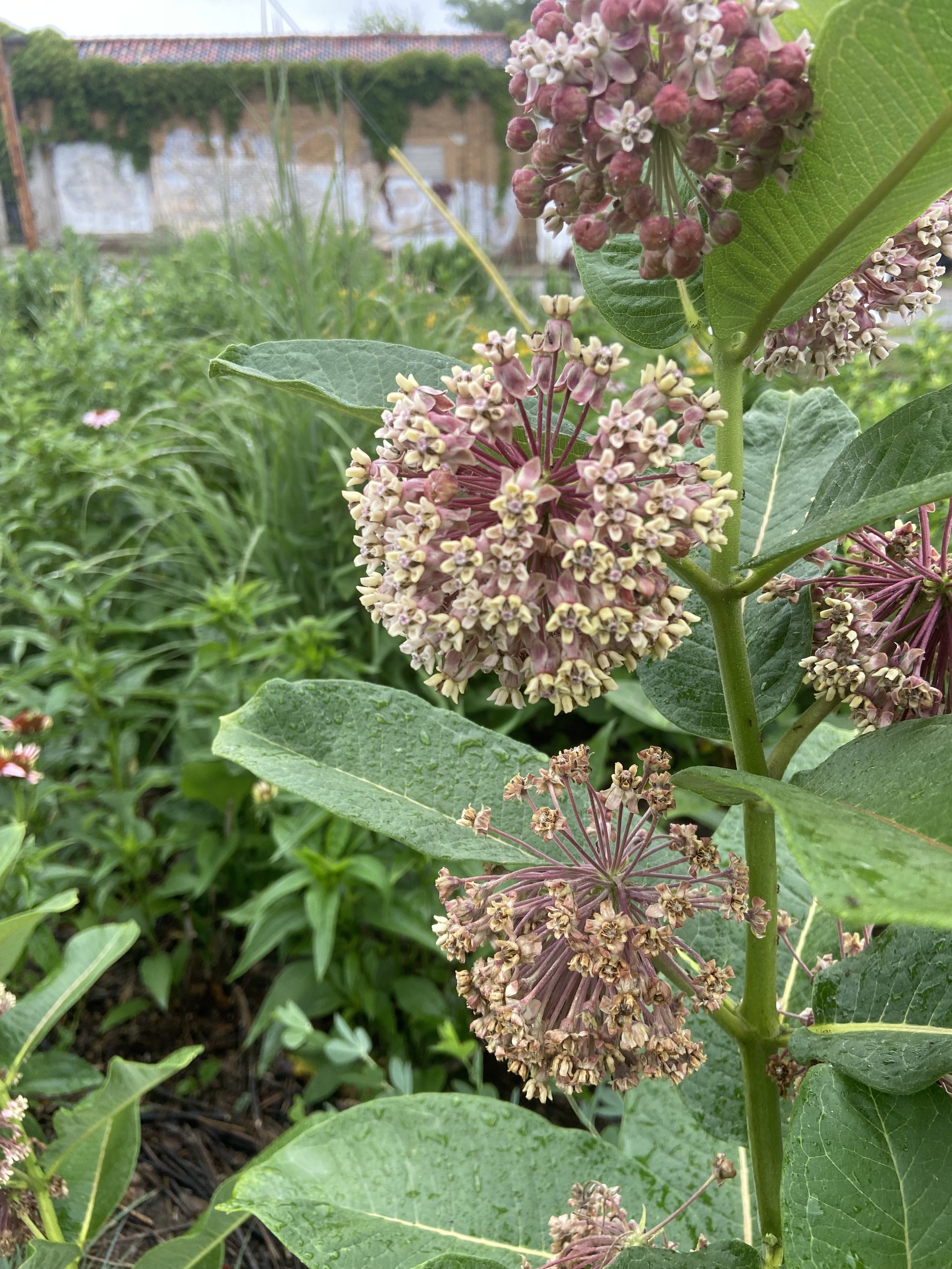
Asclepias syriaca / Common milkweed
Type: Perennial
Native habitat: Prairies, roadsides, meadows, open fields
Light: Full Sun
Soil: Dry to medium
Growth: 2’-3’ tall 1’ wide
Bloom: Pink from June-August
Spreads: Seed and rhizomesMost commonly known for being a great host plant for monarch butterflies, common milkweed is a great addition to pollinator or naturalized gardens. Does reseed rapidly, so it undesired, it is best to remove seed heads before they split open
-
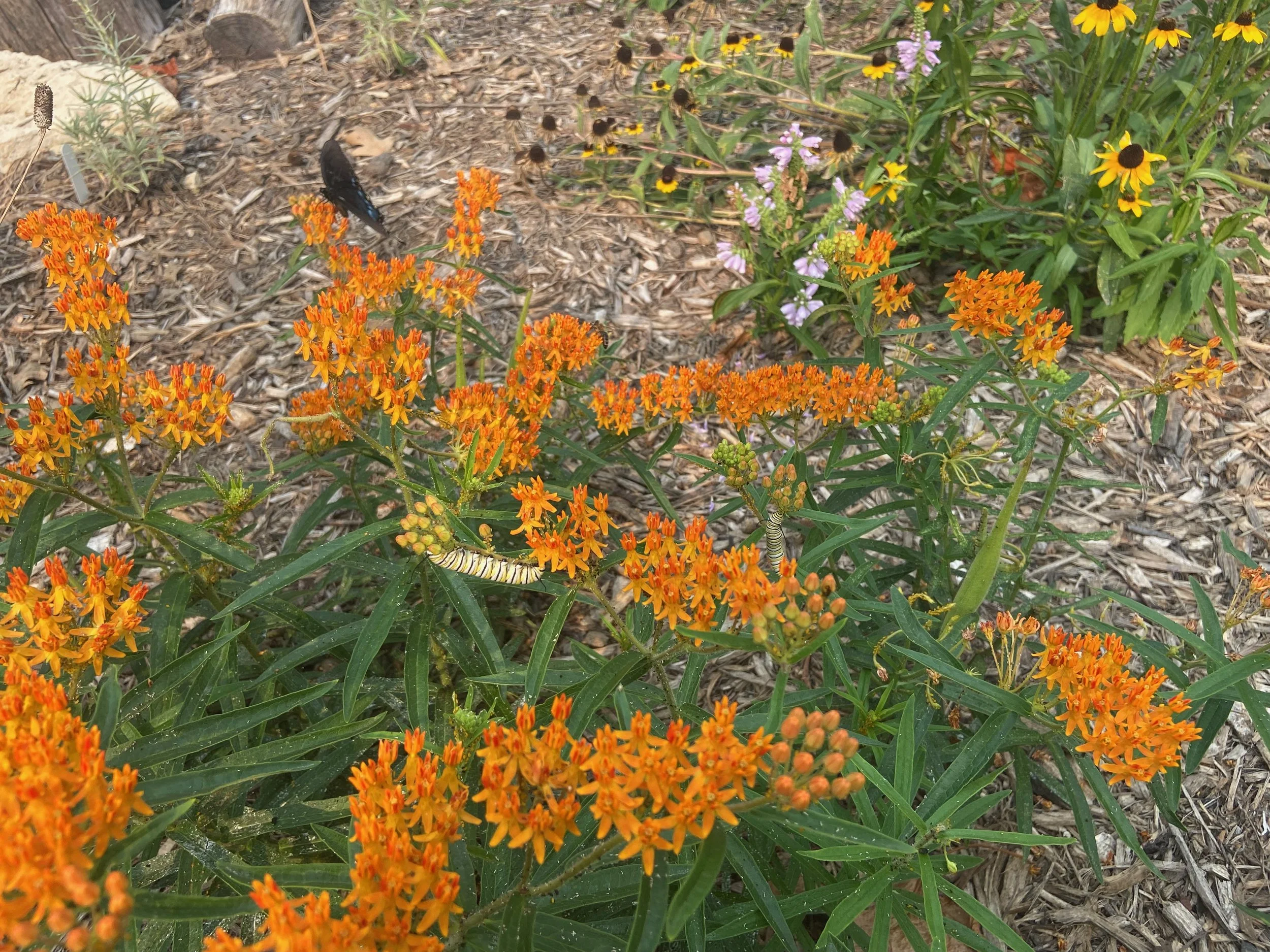
Asclepias tuberosa / Butterfly Weed
Light: Full Sun
Soil: dry to medium in poor, well drained soil
Growth: 1-2’ tall and 1’-2’ wide
Bloom: orange bloom from May-SeptA type of Milkweed, butterfly weed is a small, bushy plant with large orange flowers. Like the name suggests, this plant is great for butterflies, especially Monarch butterflies. A slow spreader that spreads mostly by seed, Butterfly milkweed is great for smaller gardens, if the soil is dry and well drained. Milkweed is prone to aphids. If noticed, treat with soapy water.
-
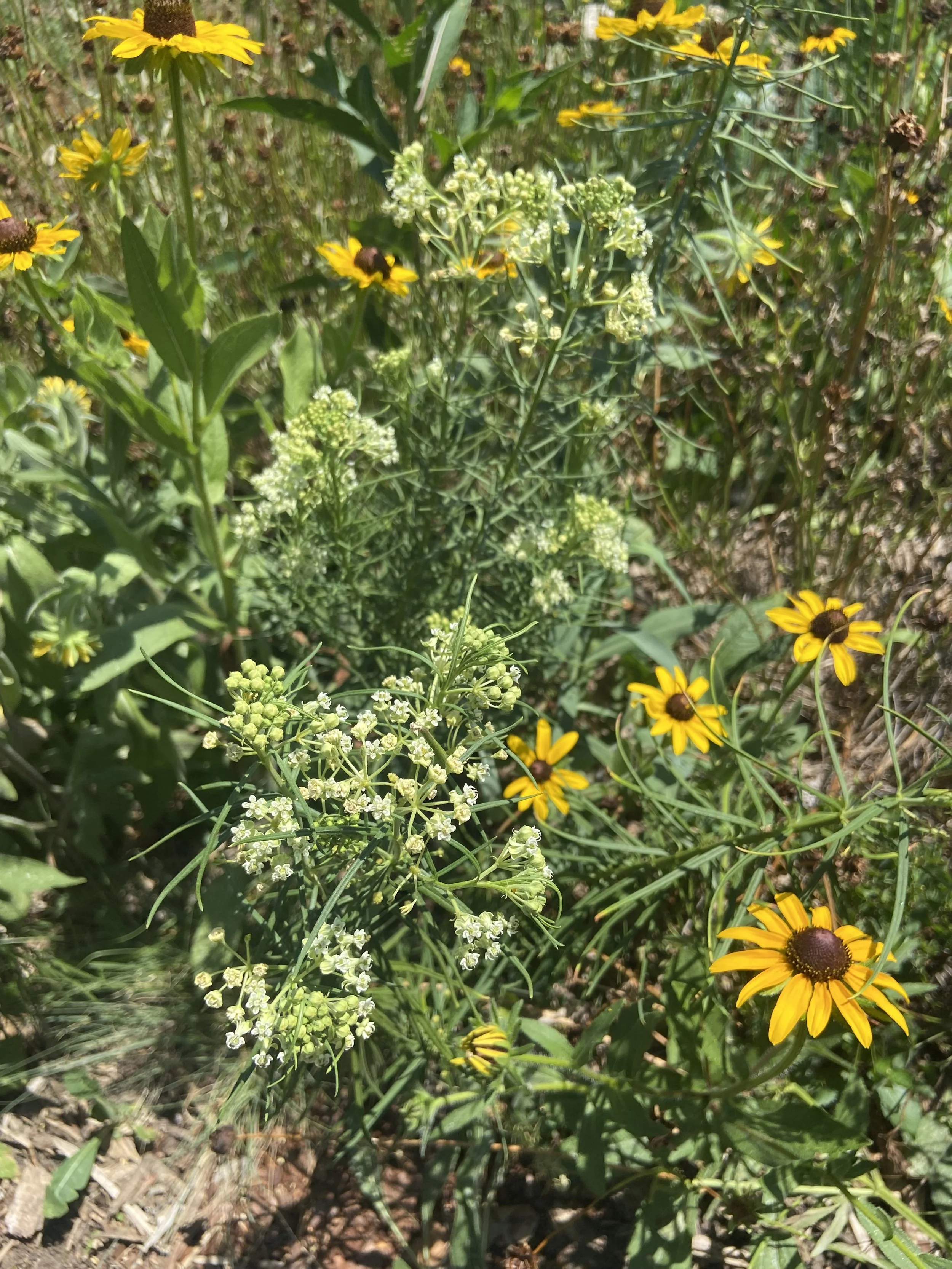
Asclepias verticillata / Whorled Milkweed
Light: Full sun to part sun
Soil: Medium to dry
Growth: 2’ tall
Bloom: White from July-SeptInfo: This shorter milkweed tends to bloom later in the year than other milkweeds. With it’s slender leaves, it is a great attractor of monarch caterpillars as well as a wide variety of other pollinators who use the nectar and pollen of the flower.
-
Baptisia alba / White Baptisia
Light: Full Sun to part shade
Soil: medium to dry
Growth: 2’-4’ tall and 2’-3’ wide
Bloom: white bloom from April-MayWild White Indigo is unique among the Baptisias that we offer due to its bloom that extends far above the foliage. Both bloom and seed pod are great for cutting flowers .
-
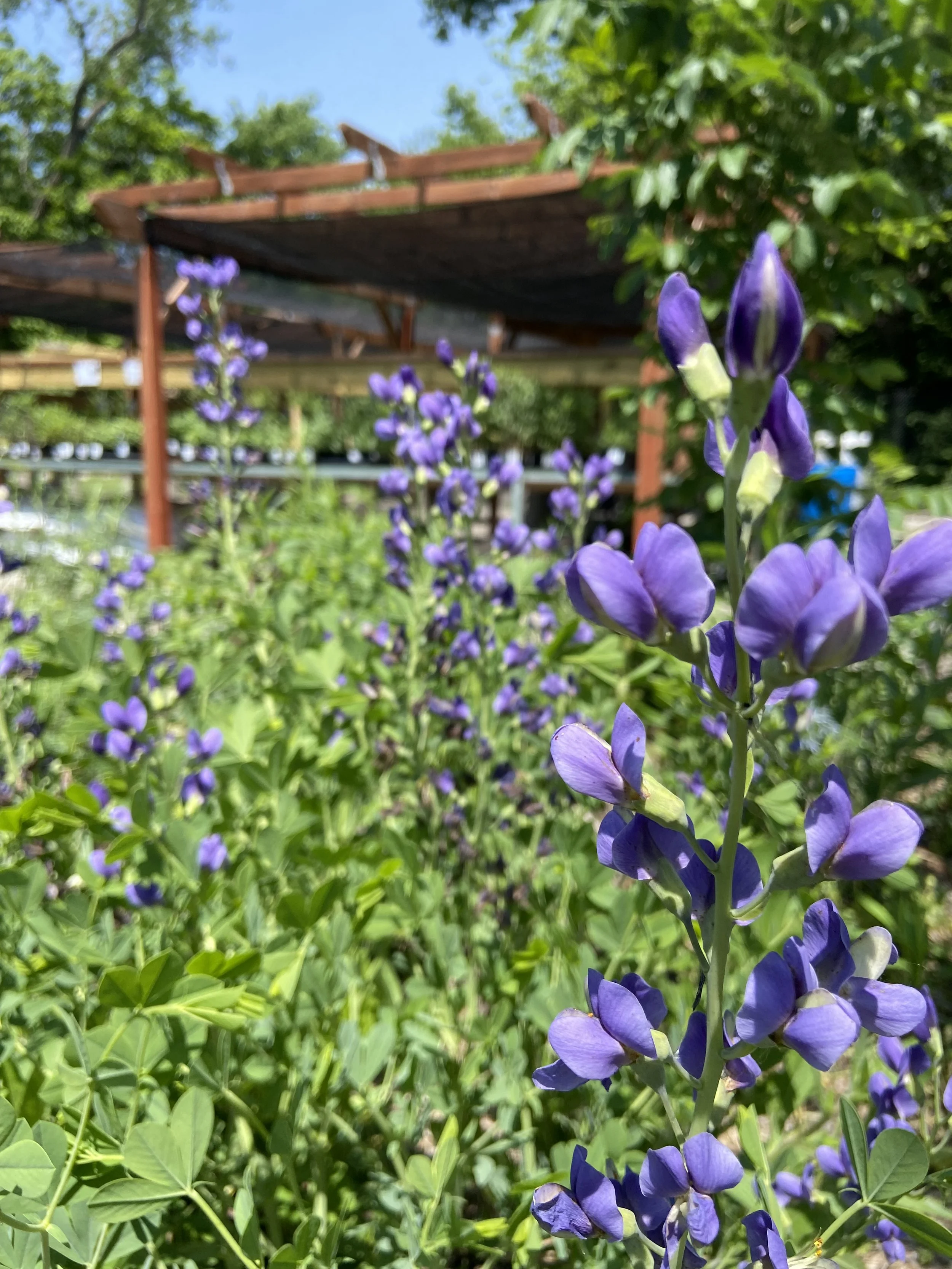
Baptisia australis / Blue Baptisia
Light: Full Sun
Soil: Medium
Growth: 3-5’ tall 3’wide
Bloom: Blue/Purple blooms April-JuneInfo: This Missouri native is found in limestone glades, the edge of woodlands, and in the prairies. This plant, like other members of the pea family is a nitrogen fixer. This plant is a wonderful addition to any pollinator garden or native planting. Along with it’s flowers being particularly beautiful, it’s seedpods are attractive through winter and fall.
-

Baptisia bracteata / Cream Baptisia
Light: Full sun/Part shade
Soil: Dry to Medium well drained
Growth: 2.5’ wide and tall
Bloom: Cream colored bloom in May-JuneNative to Missouri, Cream Wild False Indigo is a compact shrub that fits in nicely to organized or wild flower beds. The flowers and seed heads make a great addition to flower arrangements.
-

Baptisia sphaerocarpa / Yellow Baptisia
Light: Full sun / Part Shade
Soil: Dry to Medium well drained
Growth: 2.5’ wide and tall
Bloom: Yellow from June-JulyThis Baptisia is found in prairies from Texas to Missouri , but there is some question as to whether it was introduced via railroad tracks or whether it was actually native to Missouri. it is commonly found in Arkansas. Like other species of baptisia found in the state it is slow growing, but once established it has a nice mounding shape. This makes this an excellent species for formal gardens. This species is a host plant for wild indigo duskywing butterfly, several species of sulfur butterfly, and some skippers.
-
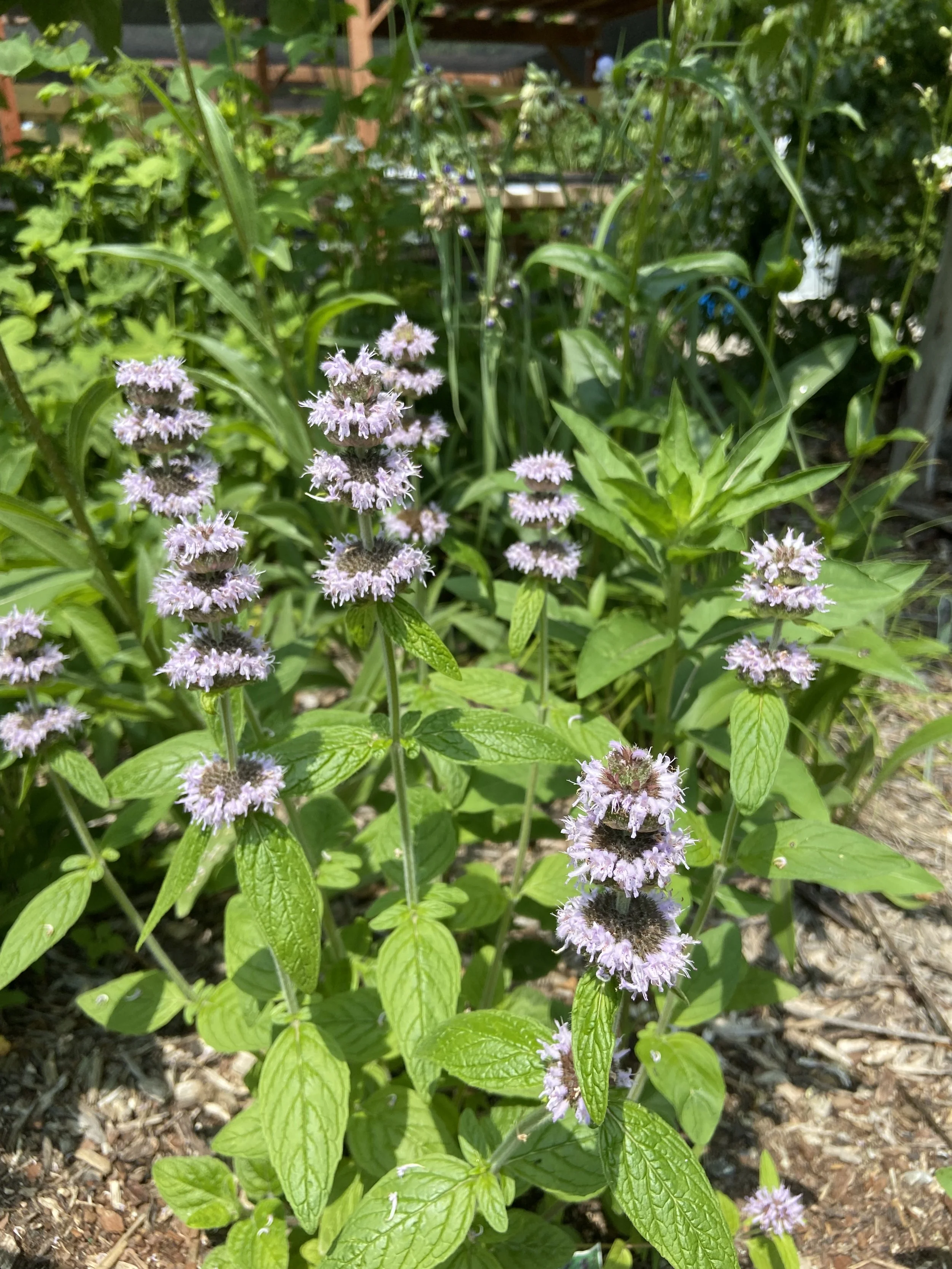
Blephilia ciliata / Ohio Horse Mint
Light: Full Sun to Part Shade
Soil Moisture: Dry to Medium
Growth: 1’-2’ tall
Bloom: Purple from May to AugustInfo: This native perennial can tolerate a wide range of light and soil conditions. It is typically found on woodland edges and openings. It is very deer resistant and a big hit with pollinators. It does spread via rhizomes to form clumps. Great for formal or wild landscapes.
-
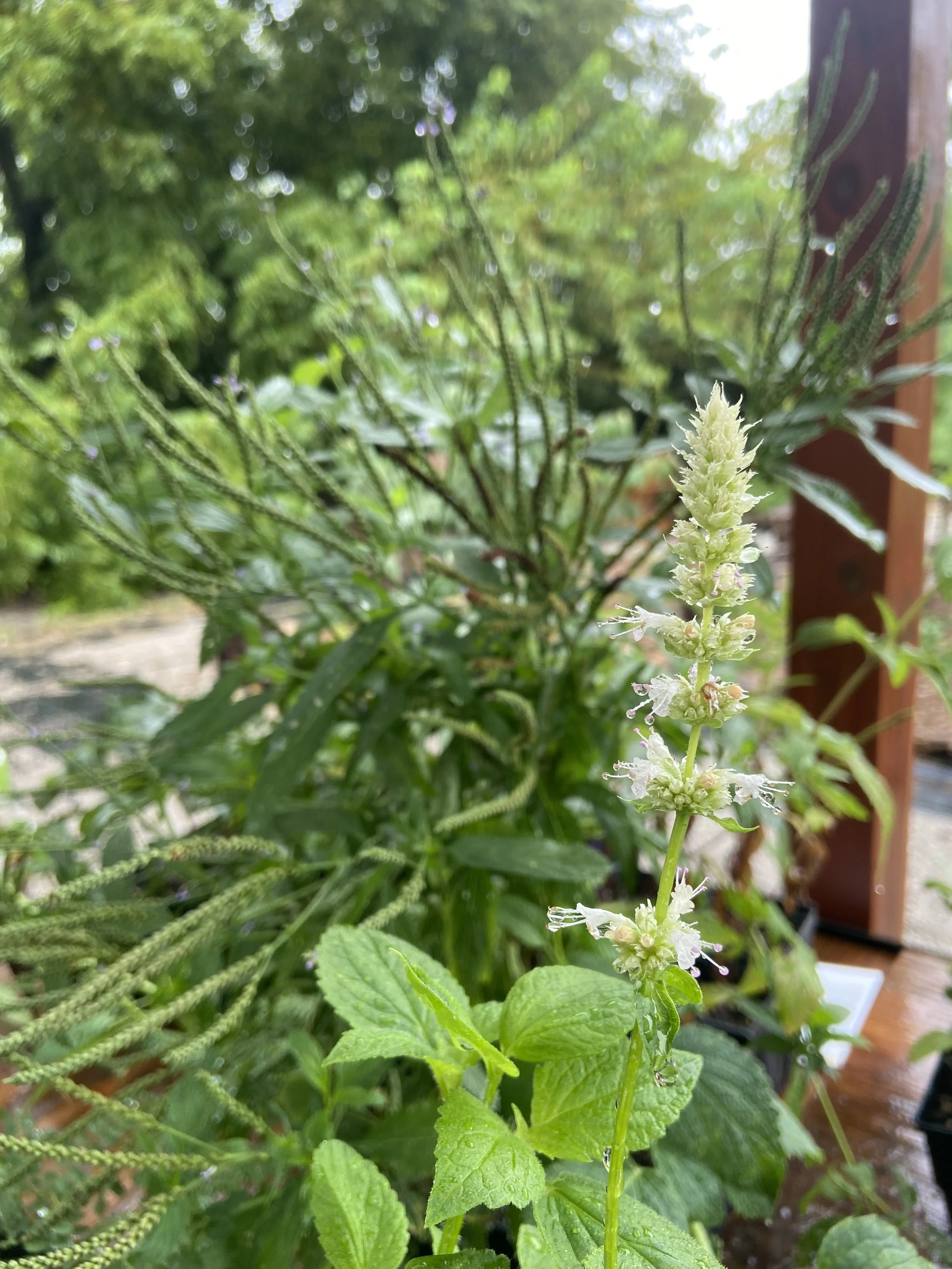
Blephilia hirsuta / Hairy Woodmint
Sun: shade to part shade
Soil: medium
Growth: 1-2.5 feet tall
Bloom: Blue/purple from May-SeptInfo: This perennial is a great attractor of a wide variety of pollinators. Great for large spaces in shade gardens as it spreads prolifically. Can also do well in small spots in the garden where it is contained, such as areas surrounded by paths and concrete. This is a great plant for those seeking to add quick benefit for pollinators.
-
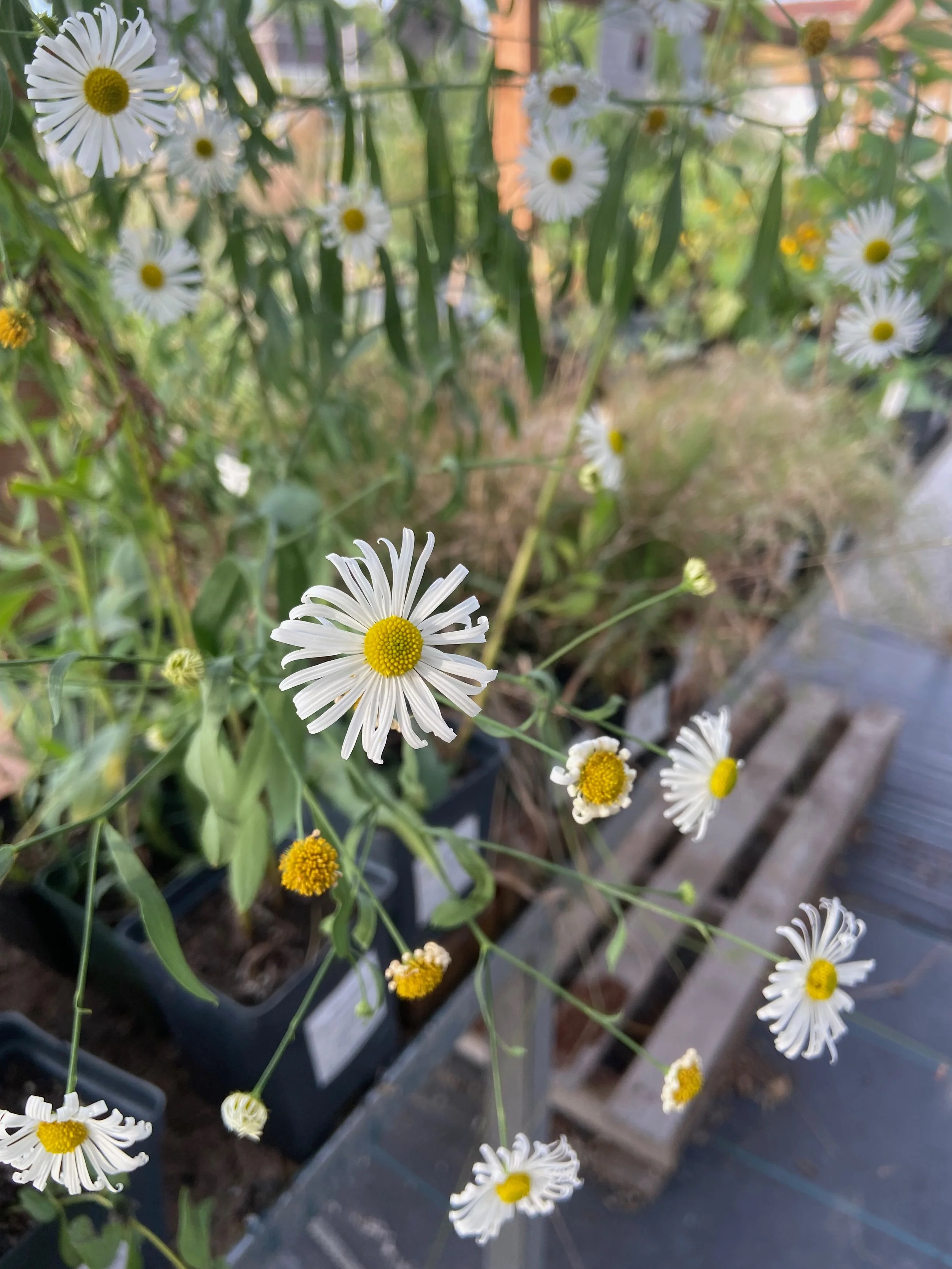
Boltonia asteroides / False Aster
Type: Herbaceous perennial
Native habitat: prairies and meadows
Light: Full Sun
Soil: Moisture: Medium
Growth: 4’-5” tall
Bloom: White from August-SeptemberGreat plant for rain gardens. Tends to spread but isn’t aggressive and is easy to weed. Beautiful, prolific bloomer and a great height for a mid range plant in almost any garden. Attractive foliage when not in bloom.
-
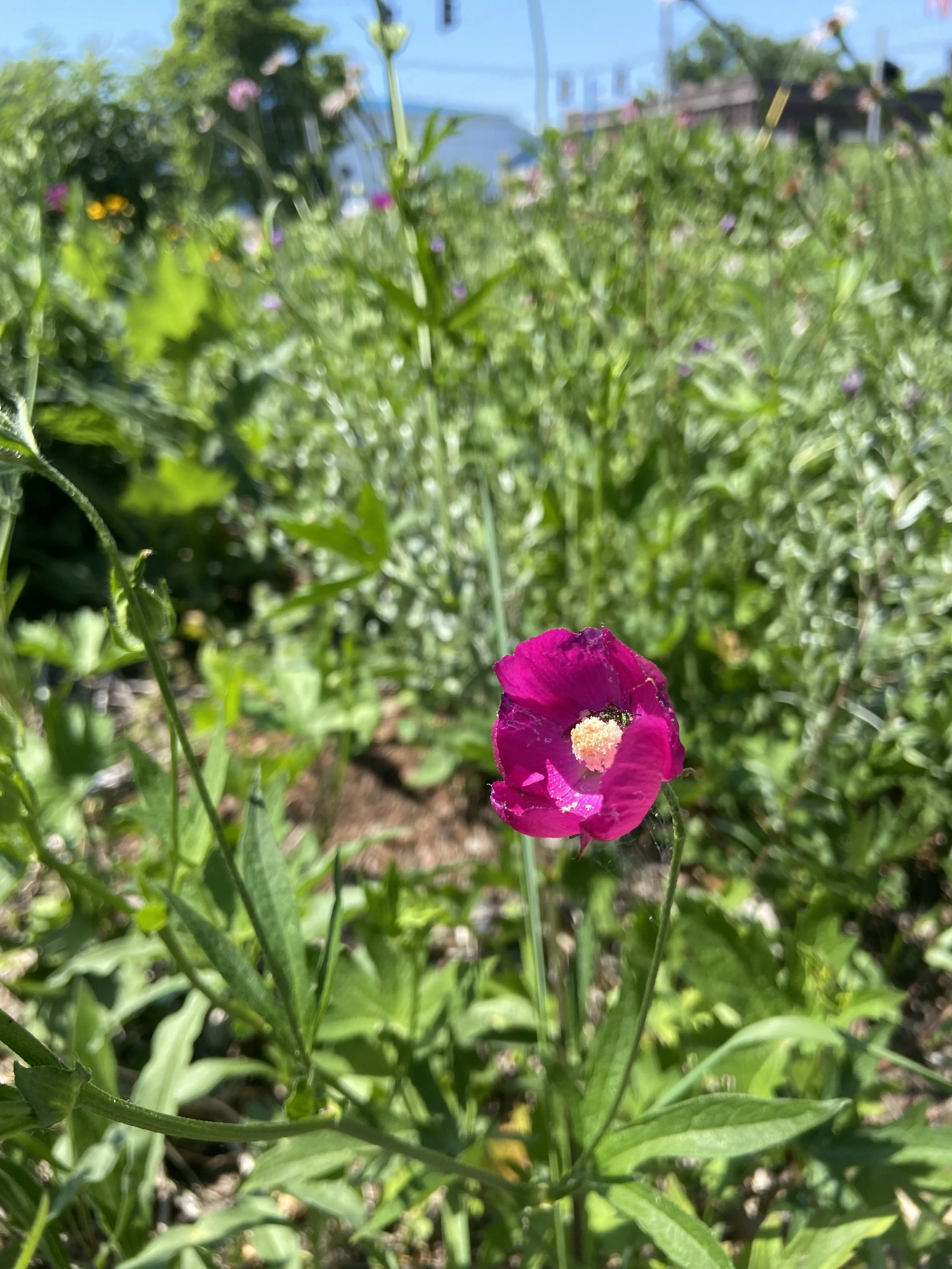
Callirhoe bushii / Bush Poppy Mallow
Light: Full sun
Soil: Dry to Medium
Growth: 2’wide 1.5’ Tall
Bloom: Magenta blooms June-AugustMostly found in open rocky areas along creek beds, this native is a great groundcover for filling in large areas in perennial beds.
-
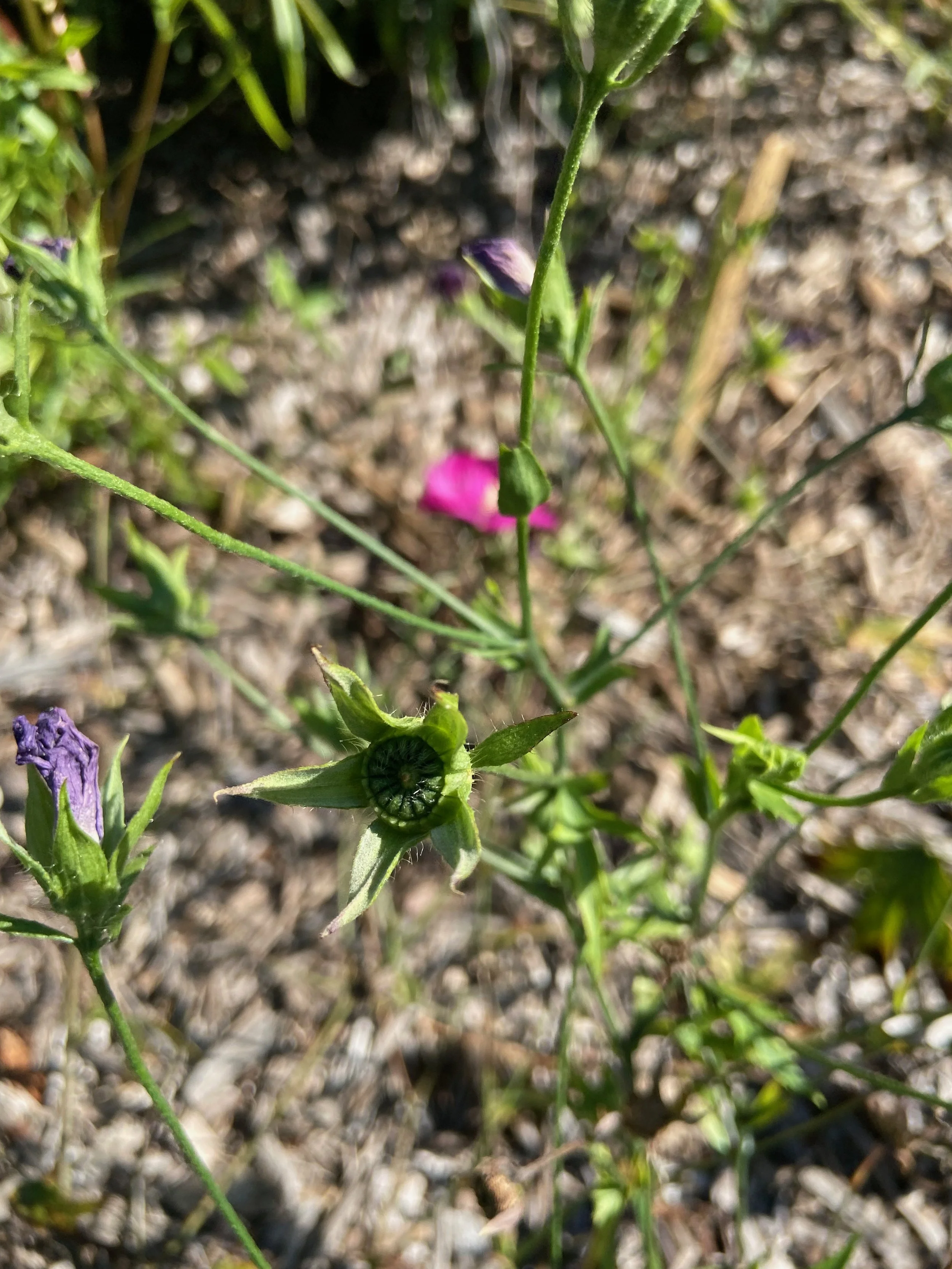
Callirhoe digitata / Fringed Poppy Mallow
Sun: Full Sun
Soil: Dry to medium
Growth: 2’-4’ tall and 1’-2’ wide
Bloom: magenta from May-SeptInfo: Unlike other poppy mallows, fringed poppy mallow stands upright rather than spreading. great for formal or natural gardens. Smaller leaves and stems than other poppy mallows
-
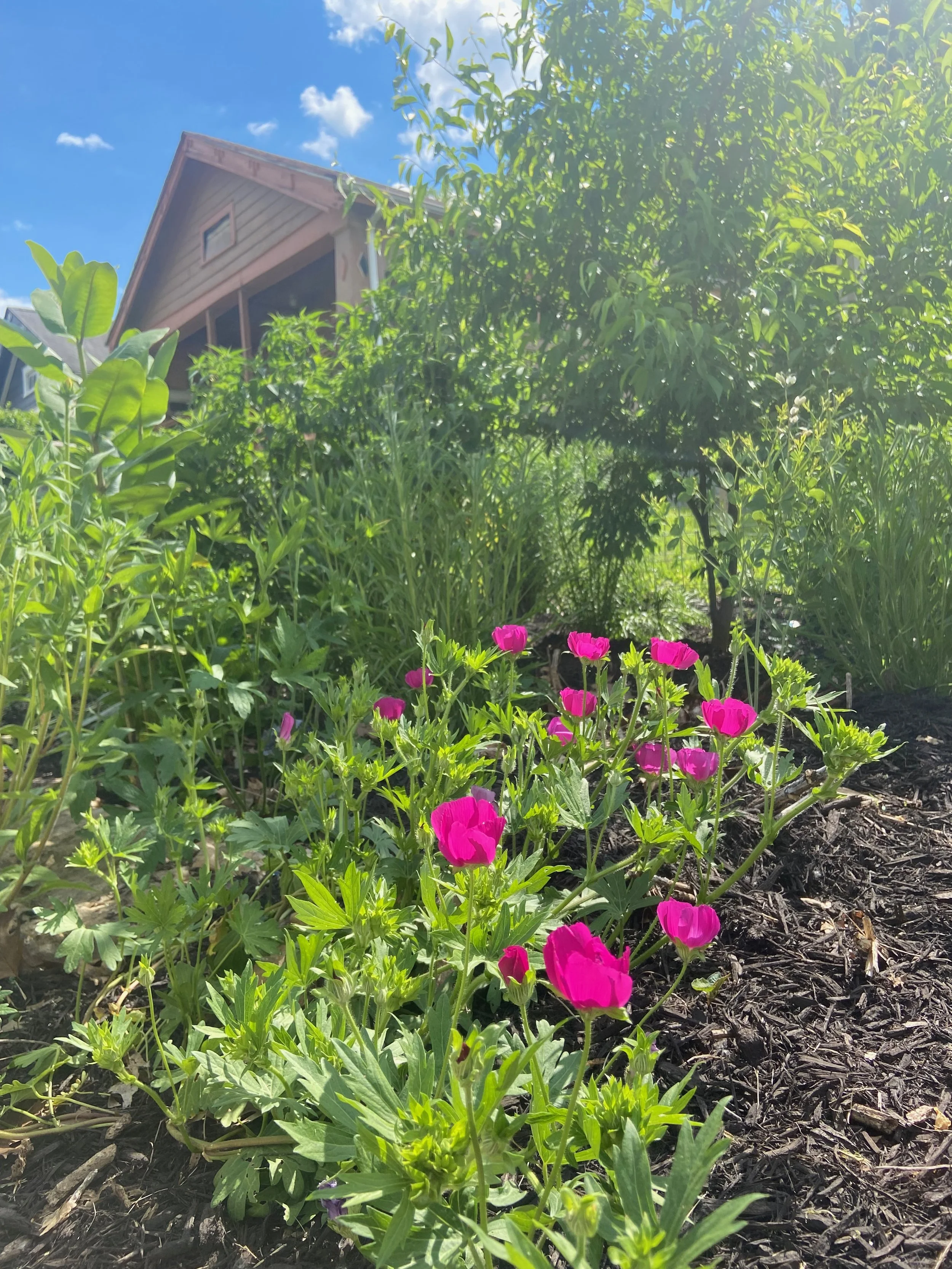
Callirhoe involucrata / Purple Poppy Mallow
Type: herbaceous perennial
Native habitat: prairies and glades
Light: Full sun
Soil: Dry to Medium
Growth: 2’ wide trailing plant by 2’ tall
Bloom: magenta bloom May-JuneNative to Missouri, Purple Poppy Mallow is a great addition to a rock garden or dry garden slope. May reseed itself if particularly happy. It is a great addition to formal gardens as well as naturalized gardens.
-

Campanula americana / Tall Bellflower
Light: part shade
Soil: medium to wet
Growth: 3’-4’ tall 3’ wide
|Bloom: Blue from June-AugustThis native biennial does not bloom it’s first year, but has low basal leaves that stay compact and close to the ground. On it’s second year, it sends up a tall stem that produces beautiful blue flowers that attract hummingbirds. Grows best in rich, moist soils.
-
Chamaecrista fasciculata / Partridge pea
Light: Full sun to part shade
Soil: medium to dry
Growth: 2’ tall
Bloom: Yellow from July-SeptInfo: Very long blooming annual legume. Prolific re-seeder. Great to use as a green mulch in naturalized gardens. Attractive to a large variety of pollinators.
This plant is an annual, so if purchased in the fall, be sure to either save seeds back to stratify and plant in the spring, or let them reseed in the garden.
-
chelone glabra / Turtlehead
Light: Part Shade
Soil Moisture: Medium to wet
Growth: 2’-3’ tall
Bloom: white from August to OctoberThis wetland perennial is a wonderful addition to any rain gardens, wetland planting, or woodland garden. Plant spreads via rhizomes to slowly form colonies. If grown in to deep of shade plants may tend to fall over, so planting next to other tall species to add support is recommended. This plant is a nectar source for both bumblebees and Ruby-Throated Hummingbirds. Flowers resemble a turtles heads thus the name.
-
Clinopodium arkansanum / Calamint
Light: Full Sun
Soil: medium to well drained
Growth: .5’ -1’ wide , .5’-1’ tall
Bloom: White/purple in June-July
Info: This low growing native perennial can be found in glades, along bluffs, and growing in gravely stream banks. plants spread by stolons and self seeding to form a groundcover. When the leaves are crushed they are very fragrant. A tea can be made from the leaves as well. This plant is a great addition to rock gardens or other dry areas.
-
Celastrus scandens / American Bittersweet
Light: Full sun to part shade
Soil: Medium to dry
Growth: up to 25 ft long
Bloom: White from May-JuneInfo: This native vine which can be found in many woodlands and thickets is known in the landscape by its red berries which can be seen in the fall and winter. This vine is a dioecious plant meaning it needs male and female plants to produce berries. Typically 1 male plant is needed for every 6 female plants. The woody vines of this plant can cause damage or death to small trees or shrubs so it is best to let it grow on arbor or trellis in the landscape. If pruning is required do this in either late winter or early spring.
-
Clematis virginiana / Virgin's bower
Light: Full sun to part shade
Soil: Medium to wet
Growth: 9ft long vine
Bloom: White from July-SeptCan be confused with sweet autumn clematis. Semi-aggressive vine that is best in large landscapes, or in contained areas where it cannot overwhelm other plants.
-
Collinsia verna / Blue eyed mary
Light: part shade
Soil: medium wet
Growth: 2’ tall
Bloom: Blue/white from April-MayInfo: Early blooming annual that does best in moist woodlands.
-
Conoclinium coelestinum / Blue Mistflower
Light: Full Sun to Part Shade
Soil: Medium
Growth: 1.5-3’ tall , 1.5-3’ Wide
Bloom: Blue blooms in July to OctoberThis Missouri native wildflower can be found in wet area likes along streams and in low wet woods. It spreads by seed dispersal and by rhizomes. in the garden this plan can be a good choice for boarders, by ponds, woodland garden, or in areas where you need a plant to readily spread
-
Coreopsis grandiflora / Large Flowered Coreopsis
Light: Full Sun
Soil: Dry to Medim
Growth: 1-1.5’ wide and 1’-2’ tall
Bloom: Yellow from June-AugustThis native perennial grows in rocky areas with good drainage. Can be deadheaded to encourage more blooms
-
Coreopsis lanceolata / Lance-leaf Coreopsis
Type: herbaceous perennial
Native habitat: prairies and glades
Light: Full Sun to Partial Shade
Soil: Dry to medium
Growth 1’-2’ tall and 1’-2’ wide
Bloom: Yellow bloom from May-JulyInfo: Prolific bloomer that is great for almost any garden. Does tend to spread by seed. In formal gardens, plan on putting in a little work to keep this plant in it’s place.
-
Coreopsis palmata / Prairie Coreopsis
Type: herbaceous perennial
Native habitat: prairies and meadows
Light: Full sun to part shade
Soil: Medium to Dry
Growth: 2’ tall
Bloom: yellow from May-JulyThis Native perennial can be found in glades, prairies, and open areas in woods. it does best in dry soils with good drainage, and will spread by seed and rhizomes. Deadhead to prolong blooming. Great for attracting butterflies.
-
Coreopsis tinctoria / Plains coreopsis
light: Full sun
Soil: Dry
Growth: 4’ tall
Bloom: Yellow rays with red centers from June-SeptThis annual is great to fill in empty spots in naturalized gardens. Reseeds readily, so will appear for years in a planting.
-
Coreopsis tripteris / Tall Coreopsis
Type: herbaceous perennial
Native habitat: prairies and meadows
Light: Full sun to part shade
Soil: Medium to dry
Growth: 7’ tall
Bloom: Yellow from July-OctGreat as an accent flower in well established beds. In the wild this flower is found in prairies, open woods, and woodland edges. This plant can spread to form large colonies, so may need to be divid every 2-3 years. Great for attracting butterflies.
-
Cunila origanoides / Dittany
Light: Full Sun to Part Sun
Soil: Dry to Medium
Growth: .75’ - 1.5’ Wide .75’ - 1.5’ Tall
Bloom: Lavender in July to September
Info: This low growing Missouri native can be found in rocky woods, along slopes, and in prairies. This plant is a member of the min family and its leaves can be used for teas, it has been used for its medicinal properties to treat headaches and fever. In addition to its pretty flowers this species also has what are commonly called “frost Flowers” where at the first frost sap is pushed out of cracks in the stem and freezes in the air to create these beautiful ribbon like ice structures.
-
Dalea candida / White prairie clover
Light: Full sun to part shade
Soil: Medium to dry
Growth: 2’ tall
Bloom: White from May-JulyThis Missouri Native perennial is common in prairies, glades, and open woods through out the state.This plant is very important in prarie restoration projects. Drought tolerant and great plant to attract a variety of bees and other pollinators. Native Americans used this plants roots for food and its leaves in teas.
-
Dalea purpurea / Purple prairie clover
Description goes hereaLight: Full sun
Soil: Medium to dry
Growth: 1-3’ tall, 1-1.5’ wide
Bloom: Purple from June-AugustThis Nitrogen fixing native plant is very important in prairie restoration projects. It is drought tolerant and great attractor of pollinators and other insects. This plant is a great addition to cottage gardens, native planting, prairie gardens, and rock gardens.
-
Delphinium exaltratum / tall larkspur
Light: Full sun
Soil: Medium to dry
Growth: 4’ - 6’ tall, 1-2’ wide
Bloom: purple from July-AugustInfo: This US Native can only be found in Missouri in some small isolated areas of southern portion of the state. Great wildflower for hummingbirds and bumblebees. Best planted in clumps and with other tall flowers around to help the flower stocks withstand strong winds. If spent flowers are dead headed this will encourage more blooms. This is a good plant for cottage gardens and native plantings.
-
Delphinium virescens / Prairie larkspur
Light: Full sun
Soil: Medium to dry
Growth: 4’ tall
Bloom: White from June-JulyGreat for bumblebees and are best planted in clumps.
-
Desmodium canadense / Showy Tick Trefoil
Light: Full sun to part shade
Soil: Medium to dry
Growth: 5’ tall
Bloom: Purple from July-AugustShowy flower that is best planted in groups. Nitrogen fixer. Can be difficult to distinguish between this plant and other showy tick trefoils
Click here for an Insect interactions table from Illinois Wildflowers
-
drymocallis arguta / Prairie Cinquefoil
Light: Full Sun
Soil: Medium
Growth: 1-3’ Tall
Bloom: White blooms in June-SeptemberThis plant prefers dry soils and is beneficial for bees.
-
Echinacea angustifolia /Narrow leaved coneflower
Light: Full
Soil: Medium to dry
Growth: 2’ tall
Bloom: Pink from June-JulySmaller, more compact version of Pale Purple Coneflower. Does best in sunny dry areas. Seeds are beneficial for many native birds.
-
Echinacea pallida / Pale Purple Coneflower
Light: Full Sun, Part Shade
Soil Moisture: Dry to medium
Growth: 2’-3’ tall 1’-1.5’ wide
Bloom: Pale Purple from June-JulyThis beautiful Missouri native is a clumping plant with the potential for many blooms. Every few years, the clumps can be divided. The flowers are great for cutting flowers.
-
Echinacea purpurea / Purple Coneflower
Light: Full sun to Part Shade
Soil: Dry to medium
Growth: 2-5’ Tall, 1.5-2’ Wide
Bloom: Purple blooms in June - AugustThis native perennial is great for mass plantings, especially when planted with other flowering perennials like black eyed susans or grasses. The clumps can be divided every 4 years or so. You can dead head plants if you wish, but plants tend to re-bloom on their own. If you leave seed heads you will find golden finches and other birds visiting to feed from the seeds.
-
Echinacea atrorubens / Tokepa coneflower
-
Echinacea paradoxa / Yellow coneflower
Type: herbaceous perennial
Native habitat: Rocky glades. Rare is Missouri
Light: Full sun
Soil: Medium to dry
Growth: 2’ -3’ tall
Width: 1’ -1.5’ wide
Bloom: Yellow from June-AugustInfo: Yellow coneflower is a great addition to pollinator gardens as it blooms in mid summer and attracts a wide variety of pollinators. As it matures, it will form large clumps with many blooms. Finches and other birds may visit the seed heads once the flowers have bloomed if the seed heads are allowed to remain on the plant. Some gardeners may want to remove seed heads for general appearance, or to prevent reseeding.
-
Echinacea simulata / Ozark Coneflower
Light: Full sun to Part shade
Soil: Medium Moisture
Bloom: Pale Pink from June to July
Growth: 2’ -3’ tallInfo: This Native echinacea can be found in glades of the Ozark region, it grows best in well drained soils. It is very drought and heat tolerant. golden finches will eat the seeds from this plant. Great for attracting butterflies.
-
Equisetum hyemale / Horsetail Reed
Light: Full sun to part shade
Soil: Medium to wet
Growth: 2’-4’ tallInfo: a beautiful, interesting plant that is a vigorous spreader. Best to be planted in a rain garden where it can have either enough space to spread, or be contained by borders that will stop it’s rhizomal spread.
-
Eryngium yuccaifolium / Rattlesnake Master
Light: Full Sun
Soil: Dry to medium/ well drained soil
Growth: 4’-5’ tall 2’-3’ wide
Bloom: Showy greenish white bloom from June-SeptInfo: A Missouri native found commonly in prairies in glades. Unique bloom and yucca like foliage adds texture and interest to the garden. The seed head can be left for winter interest, or used in cutting flower arrangements. Attracts predatory insects such as wasps and beetles. Good to be planted by vegetable gardens to attract predatory insects to combat vegetable garden pests.
-
eupatorium maculatum / Spotted Joe-Pye weed
Light: Full Sun to Part Shade
Soil Moisture: Medium
Growth: 5’-7’ tall
Bloom: Pink from July-SeptThis attractive Missouri native can grow very tall and rarely needs stalking due to the plants’ sturdy stems. The stems are ornamental as well as the showy pink flowers. Great for attracting a wide variety of pollinators.
-
Eutrochium fistulosum / Hollow Joe Pyeweed
Light: Full Sun Part Shade
Soil: medium to wet
Growth: 4’-7’ tall 2’-4’ wide
Bloom: Pink from July-SeptEasy to grow and great for tall focal plants in naturalized gardens. Also great for privacy fences or used as a hedge in the summer time.
-
Filipendula rubra / Queen of the prairie
Light: Full
Soil: Wet to medium
Growth: 5’ tall
Bloom: Pink from May-JuneThis showy native is a short bloomer, but a gem to see in mid spring. Best for wet areas where the bloom can be enjoyed.
-
Fragaria virginiana / Wild Strawberry
Description goes here -
geranium maculatum / Wild Geranium
Light: Part Shade to full sun
Soil Moisture: Medium
Growth:1’ to 1.5’
Bloom: lilac from April-MayInfo: This clumping woodland native is is great for taller ground covers or garden borders. Best planted with late blooming plants such as asters and goldenrods in order to keep the garden looking full as Wild Geraniums can disappear, or look sleepy in extreme summer heat.
-
Gillenia stipulatus / American Ipecac
Light: Full to partial
Soil: Medium wet to dry
Growth: 2’ tall
Bloom: White from May-JuneInfo: This showy native perennial grows best in full sun. its delicate blooms are sure to catch the attention of all who walk past your garden. When planted with columbines they create a wonderful fireworks display of blooms for this first part of summer. Many different species of pollinators visit this plant for its nectar and pollen. The leaves turn a beautiful red in Fall.
-
Glandularia canadensis / Rose verbena
Light: Full Sun
Soil: Dry to Medium
Growth: .5-1.5’ tall, 1-2’ wide
Bloom: Pink/purple blooms in May-AugustInfo: This Missouri Native can be found in prairies and glades throughout the state. This plant can form a attractive groundcover via its stems that root at nods where they touch the ground. Great for boarders, rock gardens, cottage gardens, even hanging baskets.
-
Helenium autumnale / Sneezeweed
Type: perennial
Native Habitat: wet meadows, ponds and streams
Light: Full Sun
Soil: Medium to moist
Growth: 3-5’ tall , 2-3’ wide
Bloom: Yellow in August - OctoberInfo: This native perennial can be found in Missouri in wet areas such as ditches, wet meadows and prairies, around ponds, and along streams. Grows best in full sun in rich moist soil, does not preform well in dry soils. This plant is beneficial for many species of adult butterflies. It does get its common name from a snuff that was made from its pollen to induce sneezing. Warning! flowers, leaves, and stems of this plant are consider !poisonous! and should not be ingested in any way.
-
Helenium flexuosum / Purple Headed Sneezeweed
Light: Full Sun
Soil: Medium to Wet
Growth: 1-3’ Tall, 1-2’ Wide
Bloom: yellow/purple in August - October
Info: This native perennial is found in Missouri in low wet areas such as ditches, along streams and ponds, and in wet prairies. If desired, This pants size can be controlled by giving it a hair cut in May. To encourage a second flush of blooms you can simply cut the plant back by half once the first round of blooms has finished. Native Americans used the dried flower heads and leaves of this pant to induce sneezing which was a treatment for colds and congestion. Leaves were also used as a laxative. Plant is beneficial to pollinators. Great for wet areas in the landscape.
-
Helianthus grosseserratus / Saw-tooth Sunflower
Description goes here -
Helianthus giganteus / Tall Sunflower
Description goes here -
Helianthus maximiliani /Maximilian's sunflower
Light: Full sun to part shade
Soil: Medium wet to dry
Growth: 7’ tall
Bloom: Yellow from August-SeptemberInfo: This Native Sunflower would have grown in the once vast tall grass prairies of the midwest, but today an be found growing on roads side in glades through out the state. Its showy flowers make it a popular addition to prairie gardens. It is beneficial to bees, butterflies, and birds.
-
Helianthus mollis / Ashy Sunflower
Light: Full Sun
Soil: Medium to Dry
Growth: 2-4’ tall, 1-3’ Wide
Bloom: Yellow in July-SeptemberInfo: This perennial sunflower is native to Missouri and grows in prairies, woodlands, and glades. It does best in well drained soil. This plant is attractive to both birds and butterflies. It is a good addition to a cottage garden or native planting, looks great in clumps.
-
Helianthus occidentalis / Western sunflower
Light: Full Sun
Soil: Dry to Medium
Growth: 2-4’ tall, 1.5-2’ wide
Bloom: Yellow in August-SeptemberInfo: This native perennial sunflower tolerates a wide range of soils from sandy to humusy soils. This sunflower is shorter then most of its relatives and is sometimes called few-leaf sunflower due to its almost bare flowering stems. This plant can be a good choice for borders and erosion control. Attractive to both birds and butterflies.
-
Heliopsis heianthoides / Early Sunflower (False Sunflower)
Light: Full Sun to light Shade
Soil: Dry to Medium
Growth: 3-6’ tall, 2-4’ wide
Bloom: Yellow/orange June - August
Info: This native perennial is not a true sunflower and is sometimes called false sunflower or ox-eye daisy. This plants hight can be controlled by a hair cut in May by cutting back 1/3rd to 1/2 the plant this will reduce total height by later in the season when blooming begins. This plat is beneficial to hummingbirds.
-
Heuchera parviflora / Little flowered alumroot
Light: Full sun to part shade
Soil: Medium
Growth: 1’ tall
Bloom: White from July-SeptInfo: If placed in the sun, plant needs consistent moisture. Great for a ground cover in formal gardens.
-
Heuchera richardsonii / Alum Root
Light: Full Sun to Part Shade
Soil Moisture: Dry to Medium
Growth: 1’-2’ tall
Bloom: Green From June-JulyInfo: This perennial plant is Missouris native coral bell. In the wild you can find them in open woodlands and in prairies. They prefer rich soil that is well drained in partial shade, can take full sun but may need some afternoon shade in the hot summer months. Clumps are easy to divide in the spring, you can do this about every 4 years to spread them around in the garden. This plant is attractive to both hummingbirds and bees. This plat is a great groundcover for native plantings in either a woodland or prairie style.
-
Hibiscus laevis / Rose Mallow
Light: Full Sun
Soil: Medium to wet
Growth: 2’-3’wide and 4’-6’ tall
Bloom: White bloom with red center from Aug-SeptThis Missouri native is found in swamps and along ponds. It is a wonderful addition to both naturalized and formal gardens. Tends to spread by seed, but seedlings are easy to weed out of the garden.
-
Hydrophyllum virginianum / Virginia Waterleaf
Light: Part Shade
Soil: medium to wet
Growth: 1-2’ tall, 1-2’ wide
Bloom: White/lilac in May to June
Info: This native perennial grows best in moist woodlands and likes soil that is well drained but never dry. in the ideal growing conditions this plant can become a low maintenance groundcover. Attractive to bumble bees.
-
Iodanthus Pinnatifidus / Purple rocket
Light: Part shade to full shade
Soil: wet to average
Growth: 2.5’
Bloom: lavendar from May - June -
Iris cristata / Dwarf Crested Iris
Light: Full sun to part shade
Soil: Medium moisture
Growth: .5’-.75’ tal
Bloom: Blue in AprilInfo: Excellent small plant for ground cover in woodland gardens. Will spread to form a clump that can be divided every few years and spread even further through the garden. Prefers moist soil.
-
Iris fulva / Copper Iris
Type: Perennial
Native habitat: swampy woods
Light: Full sun to part shade
Soil: medium to wet
Growth: 2’-3’ tall
Bloom: Copper from May-JuneInfo: This native iris is beardless and tends to live in wetlands in the wild. Great for rain gardens or areas that are wet during the rainy season. Is occasionally visited by hummingbirds
-
Iris virginica / Southern Blue Flag
Type: Perennial
Native habitat: wetlands
Sun: Full Sun
Soil Moisture: medium to wet
Growth: 2’-4’ tall
Bloom: White/blue in JuneInfo: This beautiful native iris needs does well in formal or naturalized gardens. It does best in very wet soil.
-
Liatris aspera / Button Blazing Star
This clumping native perennial that sends up a narrow flower stalk is called button blazing star and is different from some other liatris in that each bloom on the flowering stalk are father apart and looks more like a bunch of tiny round blooms (buttons) rather then one cylindrical flower.
Light: Full Sun
Soil: dry to medium
Growth: 2’-3’ tall 1’-2’ wide
Bloom: Purple from August to October
-
Liatris pycnostachya / Prairie Blazing Star
Light: Full Sun
Soil: dry to medium
Growth: 2’-5’ tall 1’-2’ wide
Bloom: Purple from July-AugustThis Missouri native is perfect for butterflies and hummingbirds. It is a beautiful cutting flower and goes well in either formal or native gardens
-
Liatris scariosa / Northern Blazing Star
Light: Full Sun
Soil: Medium to Dry
Growth: 2-4’ Tall, 1-2’ Wide
Bloom: Purple in August - October
Info: This native liatris can be found in dry rocky areas of prairies. It can not tolerate wet areas during the winter and does best in well drained soil year round. This is a very attractive member of the liatris species and is very popular in landscape designs. It is also very popular with butterflies.
-
Lobelia Cardinalis / Cardinal Flower
Type: biennial
Native habitat: low woodlands, stream banks
Light: Full sun to part shade
Soil: Medium to wet humus or fertile soil
Growth: 2’-4’ tall 1’-2’ wide
Bloom: Showy red July-SeptInfo: Lobelia cardinalis, or cardinal flower, is a short-lived native perennial known for its striking red tubular flowers attracting pollinators and hummingbirds. It thrives in moist soil, partial shade, and can grow up to 4 feet tall. Low maintenance, it's valued in gardens and restoration projects but may spread vigorously in optimal growing conditions.
-
Lobelia siphilitica / Great Blue Lobelia
Type: perennial
Native range: wetlands, lowlands, stream banks
Light: Full Sun to Part Shade
Soil: Medium to Wet
Growth: 2-3’ Tall, 1-1.5’ Wide
Bloom: Blue in July-SeptemberInfo: This native perennial can create lovely colonies after years of self seeding. It grows best in rich wet soils that stay constantly moist. This lobelia can take full sun but some afternoon shade is ideal in hotter climates. Great for attracting humming birds to your back yard and is a wonderful addition to any woodland garden.
-
Mertensia virginica / Virginia Bluebells
Sun: Part shade, Shade
Soil: moist to medium
Growth: 2’ tall
Bloom: Blue from April-MayThis beautiful spring ephemeral can form large colonies over time. They are great for pollinators and die back in the heat of the summer, leaving way for other summer plants to express their beauty.
-
Mimulus ringens / Monkey Flower
Light: Full Sun to part Shade
Soil: Medium to Wet
Growth: 1-3’ Tall, 1’ Wide
Bloom: Lilac/Purple in June-SeptemberInfo: This Missouri native can be found in low woods and swamps. It is a larval host of common buckeye caterpillars, and Baltimore checkerspot caterpillars. The blooms are also attractive to adult butterflies. Great for rain gardens or other wet areas in the landscape.
-
Monarda bradburiana / Bradbury's Monarda
Type: perennial
Native habitat: prairies
Light: Full Sun to Part Shade
Soil: Medium
Growth: 2’ tall, 1-1.5’ wide
Bloom: Pink/Purple in June-JulyInfo: This native monarda is much more compact then other species. it only stands about 2 foot high. It is also very flexible on soil types and sun exposure making it a great addition to any landscape. Great for attracting pollinators and is very aromatic.
-
Monarda fistulosa / Wild Bergamot
Type: perennial
Native habitat: prairies
Light: Full sun
Soil: Dry to medium
Growth: 2-3’ wide and 2-5’ tall
Bloom: Lavender from June- JulyInfo: This native clump forming perennial is a part of the mint family. It is attractive to bees and butterflies as well as a great addition to any herb garden. The leaves of this plant have been used to make teas. In wet or shady areas, this plant can get powdery mildew. This generally doesn’t hurt the plant, but can look bad. Planting plants such as Aromatic aster in front of Wild bergamot can help hide the defoliation caused by powdery mildew while providing food for pollinators later in the season.
-
Monarda punctata / Spotted Bee balm
Type: perennial
Native habitat: prairie
Light: Full sun / part shade
Soil: Medium to dry
Growth: 2’ tall
Bloom: Yellow/green/white/Purple from July-SeptInfo: This Native perennial is a very showy addition to the garden. In the wild you could find this stunning plant in prairies, savannas, and meadows. This plants leaves can be used medicinal in teas to ease backaches. This species is also beneficial for bees.
-
Oenothera macrocarpa / Missouri Evening Primrose
Type: perennial
Native habitat: prairie glades
Light: Full Sun
Soil: dry to medium
Growth: 1’ tall by 1’-1.5’ wide
Bloom: yellow bloom from May-AugustInfo: This easy to grow native has yellow fragrant flowers that open up in the late afternoon. This plant is pollinated by night time pollinators. Missouri evening primrose makes a good ground cover and is great for boarders or rock garden plantings. It is slow to spread by seed. Taproot makes it difficult to transplant. Leaves grow off of parts last year’s growth, so don’t remove dead stems from last year until the plant begins to leaf out again in Spring
-
packera aura / golden ragwort
Light: Full Sun to Part shade
Soil: Medium to Wet
Growth: .5’ - 2.5’ Tall .5- 1.5’ Wide
Bloom: Yellow in AprilInfo: This Member of the Packera family is called Golden ragwort or golden groundsel most commonly. This plant self seeds to form large colonies and makes a very nice groundcover. The basal leaves are semi evergreen so in combination with its spring flowers this plant has year round interest. Attracts butterflies.
-
Packera obovata / Roundleaf groundsel
Light: Full sun to part shade
Soil moisture: medium to wet
Height: 1’
Spread: 1’
Bloom: Yellow from April - JuneInfo: Roundleaf groundsel is an excellent ground cover for prairie plantings, or part shade plantings. One of the first plants to bloom in spring, it an excellent perennial to plant to benefit pollinators. Roundleaf groundsel will sporead rapidly by seed to create a ground cover and is relatively well behaved around other plants. Bloom can get a little taller than 1’ but cut off the seed heads after they go to seed and the leaves will be a beautiful ground cover.
-
Parthenium integrifolium / Wild Quinine
Type: perennial
Native habitat: prairies and glades
Light: Full sun
Soil: medium wet to medium dry
Growth: 4’ tall
Bloom: white from June-SeptPollinators: Haicitne bees
Info: This Native perennial can be found in many prairies and glades. it grows best in well drained soils in full sun. This is a great addition to native plantings and cottage gardens.
-
Passiflora incamata / Purple Passion Flower
Light: Full sun, Partial sun
Soil: medium
Height: up to 20’ fine
Bloom: Purple June-OctoberThis unusual native Vine is a fast growing fast spreading perennial vine. This vine has very showy flower which gives way to edible fruit which are sometimes called Maypops, because of the sound they make when stepped on. This vine is a good choice for growing on trellises and on fences.
-
Phemeranthus calycinus / Rock Pink (Fame Flower)
Light: Full Sun
Soil: Dry well drained soil
Growth: 1’ tall
Bloom: Pink from June-AugustInfo: Easily grown colony forming perennial. Grows best in rocky soils where it is not in competition with other plants. Rock pinks do poorly in soils that don’t drain well. Can be used in container plantings. Other common name is Fame flower
-
Phlox divaricata / Wild Blue Phlox
Light: Part Shade/Full Shade
Soil: Medium
Growth 1’wide 1’ Tall
Bloom: violet/blue blooms April-May
Info: This native woodland wildflower is perennial and often called Wild Sweet William. It starts blooming in early spring and grows best in rich soils. It can form lovely colonies over time and looks wonderful planted in areas with other spring wildflowers or spring bulbs. Its shallow roots make it ideal to plant in areas with allium, daffodil, and tulips bulbs.
-
phlox pilosa / Priarie Phlox
Light: Full Sun
Soil Moisture: medium
Growth: 1’-2’ tall
Bloom: Pink bloom May-JulyThis clumping native spreads easily and is great for filling in large sunny areas
-
physostegia angustifolia / Early obedient plant
Light: Full sun
Soil: Medium moisture
Growth: 4’ tall
Bloom: Pink from August-Sept
Info: easy to grow. Spreads by Rhizomes and can be aggressive. Best to divide every few years to help keep from growing in undesired places
-
Physostegia virginiana / Obedient plant
Type: Perennial
Native habitat: wet prairies, stream banks
Light: Full sun
Soil: medium, well drained soil
Growth: 3’-4’ tall and 2’-3’ wide
Bloom: Purple from July-SeptThis Missouri native grows is great in natural or formal gardens. It’s flowers are great for cutting flowers. Spreads quickly by seed and rhizome, so best to plant in large areas, or plan to remove unwanted spreading a few times a year. Excellent plant to attract hummingbirds and bees. Check for water during drought years to ensure a bloom.
-
Penstemon cobaea / Showy Beardtongue
Type: perennial
Native habitat: rocky prairies
Light: Full Sun
Soil: dry, well drained
Growth: 1’-2’ tall 1’-1.5’ wide
Bloom: pink or violet in MayShowy, beautiful native is great for formal or natural gardens. Spreads somewhat slowly, but it’s large, very attractive bloom adds quite a bit of interest in the early summer months. Also great for pollinators. If you are lucky, you can catch bumblebees resting in these flowers. Would highly recommend in most sunny spots with average moisture. Looks great planted with Missouri evening primrose, pale purple coneflower and lance leaf coreopsis, which all bloom at the same time.
-
Penstemon digitalis / Foxglove Beardtongue
Type: short lived perennial
Native habitat: prairies
Light: Full Sun
Soil: dry to medium
Bloom: White from May-June
Growth: 3’-5’ tallInfo: This native perennial is an excellent showy plant for naturalized or rain gardens. Commonly visited by long-tongued bees. Can grow to be 5 feet tall on warm wet years. Looks really great planted as a centerpiece for spring gardens, since it is one of the early plants to grow to a decent height. Can also be planted in mass in the back of the garden for a large show of flowers. it is not very aggressive, so be sure to give it room, if planted by aggressive plants. In terms of maintenance, it is a semi-evergreen plant and spreads fairly well by seed. First week of March, or late November are great time to edit out unwanted beardtongues as they are easy to see and it gives you an excuse to get out and explore in the garden when it’s cold.
-
Penstemon grandiflorus / Large Flowered Beardtongue
Light: Full Sun
Soil: Dry to Medium
Growth: 2’-4’ tall
Bloom: Lavender blue from May-June
Info: Large flowered beardtongue is a short lived perennial that is best for the back of sunny gardens. looks amazing in large clumps
-
Penstemon pallidus / Pale Beardtongue
Light: Full sun to part shade
Soil: Medium to dry
Growth": 1’ tall
Bloom: White from May-JulyPollinator: host for Chalcedon Chekerspot and Edith’s Checkerspot
Info: This plant grows best in dry rocky soils in prairies and along bluffs. This plant’s old flowers stems can be cut back to encourage more blooms.
-
polemonium reptans / Jacob's Laddar
Sun: Full Shade or Part Shade
Soil: medium
Growth: 1’-1.5’ tall 1’-1'.5’ wide
Bloom: Blue from April - JuneInfo: This shade native is great for native shade landscapes or rock gardens. It has a clump forming growth habit and grows best in rich humus soil in part shade.
-
pycnanthemum verticillatum / hairy mountain mint
Light: Full sun to part shade
Soil: medium to dry
Growth: 3’ tall
Bloom: White from July-Aug
-
pycnanthemum tenuifolium / Slender mountain mint
Light: Full sun to part shade
Soil: Dry to medium
Growth: 3’ tall and 3’ wide
Bloom: White from July-Sept
Info: This plant often called Mountain mint does not actually grow in the mountains it is mainly fond in prairies and open woods. This plants leaves have a strong mint aroma when crushed. Fresh leaves can be rubbed on the skin to help repel mosquitoes. Dried leaves can be used in teas. This pant is very attractive to bees and butterflies, deer do enjoy eating the foliage, and many small animals eat the seeds.
-
Ratibida columnifera / Long Headed Coneflower
Type: Perennial
Native habitat: prairie
Light: Full Sun
Soil Moisture: dry to medium
Growth: 1’-3’ tall
Bloom: yellow/brown from June-SeptInfo: This native perennial is slightly rare in Missouri but from time to time can be found in prairies, along railroads, and along road sides. It is more common in Kansas. This plant is beneficial for bees, butterflies, and birds. It is also a medicinal plant and its leaves, flowers, and stems can be each used separately to make different teas for different types of aliments. In landscapes these look very nice planted in groups, planted in pots, or used in rock gardens.
-
Ratibida pinnata / Grey Headed Coneflower
Type: Perennial
Native habitat: prairie
Light: Full Sun
Soil: Well drained soil
Growth: 3-5’ tall and 1.5-2’ wide
Bloom: yellow from June-AugustInfo: This perennial is found in the savannas, glades and woodlands in the midwest. It is deer and drought tolerant. A prolific spreader, best in given a large space to grow.
-
Rudbeckia fulgida / Orange coneflower
Light: Full sun to part shade
Soil: medium to moist
Bloom: Yellow (slightly orange) from July - Oct
Growth: 1’ -3’Info: Great plant for bees and birds. Self seeds to form large clumps, or fill in empty spots in gardens. Looks best as a border plant in large clumps and can be used as cut flowers. Will grow in dry soil and through light droughts, but would prefer an area with average moisture.
-
Rudbeckia hirta / Black Eyed Susan
Light: Full Sun
Soil: Dry to moist
Growth: 1-3 feet tall
Bloom: yellow bloom June-SeptemberInfo: This common native perennial is short lived but if allowed to reseed you will always have some in the garden. Most often the plant only forms a rosette of leaves near the ground its fist year, and then in its second year blooms. In the wild this plant can be found in woods, prairies, glades, and savannas. It can tolerate moist to dry soils. This plant is important for bees, butterflies, and birds. It is the larval host of the Gorgone Checkerspot and Bordered Patch Butterfly. Native Americans used this plants root in teas for worms and colds. They made a wash with the roots for treating sores and snakebites.
-
Rudbeckia laciniata / Wild Goldenglow
Light: Full sun to full shade
Growth: 7’ tall
Soil: Medium to wet
Bloom: yellow from July-OctoberInfo: This native perennial grows in rich woods and thickets. One of the few Rudbeckias that can take full shade. seeds of this plant are eaten by birds. The Cherokee would boil the early spring foliage and eat is as a green. This plant is great addition to woodland gardens, edible food forests, and great as a backdrop in the landscape.
If planted in the sun, it can suffer in dry conditions. Best planted in part shade medium wet soil. In the sun, it will grow taller than in the shade.
-
Rudbeckia missouriensis / Missouri Coneflower
Type: perennial
Native habitat: prairie
Light: Full sun
Soil: dry to average and some drought
Growth: 2’ -3’ tall
Bloom: Yellow from June - OctoberInfo: Missouri coneflower is a colony forming small perennial with a long bloom time. Naturally occurring in glades, this plant does well in naturalized gardens, where it can be allowed to spread by seed. The long blooming perennial attracts pollinators in the summer and birds that eat it’s seeds in the fall.
-
Rudbeckia subtomentosa / Sweet black-eyed Susan
Light: Full Sun to Part Shade
Soil Moisture: Medium
Growth: 3’-5’ tall
Bloom: Yellow from July-OctoberInfo: Very hearty prairie perennial. Great for landscapes and in rain gardens. This species of rudbeckia has a very long bloom period spanning from summer into the first half of fall. some people also grow this plant to be used as a cutting flower.
-
Rudbeckia triloba / Browneyed Susan
Light: Full sun
Soil: Medium moisture
Growth: 3’ tall, 1-1.5’ wide
Bloom: Yellow July-OctInfo: This native plant is considered a biennial or a short live perennial. It grows best in well drained soils in full sun. Has a clump forming growth habit. If allowed to self seed you will always have new one popping up in the garden. seeds are eaten by birds.
-
ruellia strepens / Smooth Wild Petunia
Light: Part shade
Soil: Medium to moist
Growth: 1-3’ Tall, 1-1.5 Wide
Bloom: Lavender in May-SeptemberInfo: This Native wildflower can be found in open woods and thickets. It grows best in rich soil in part shade. This is a great addition to woodland and shade gardens.
-
Ruellia humilis / Wild petunia
Light: Full sun to part shade
Soil: Medium to dry
Growth: 1-2’ tall
Bloom: Purple from June-AugustThis native perennial has a sprawling growth habit making it a wonderful groundcover. If plants are watered trough the heat of summer plants will continue blooming. In the wild this plant can be found on the edge of woodlands. It is the larval host for several species of butterfly including buckeye butterflies.


